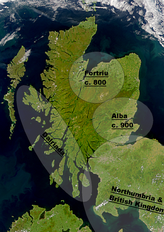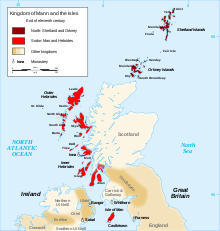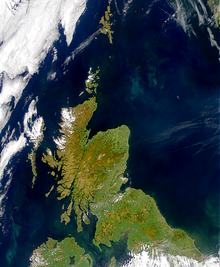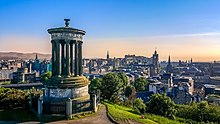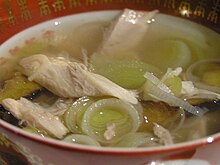اسكتلندا
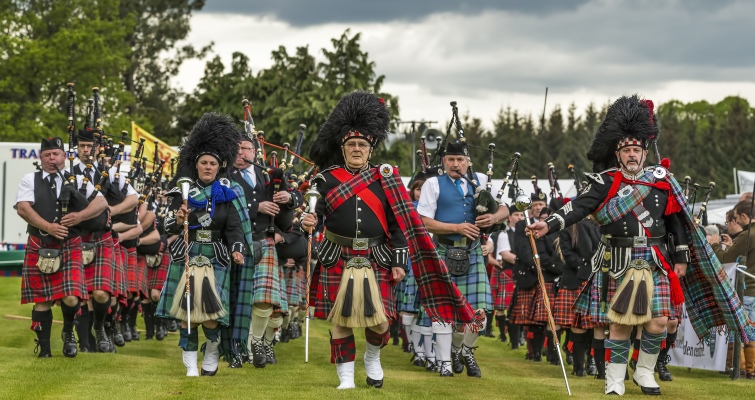

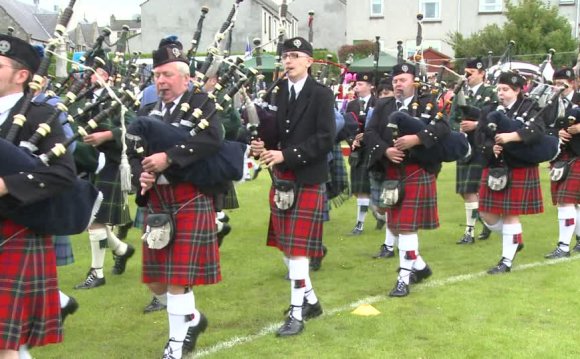
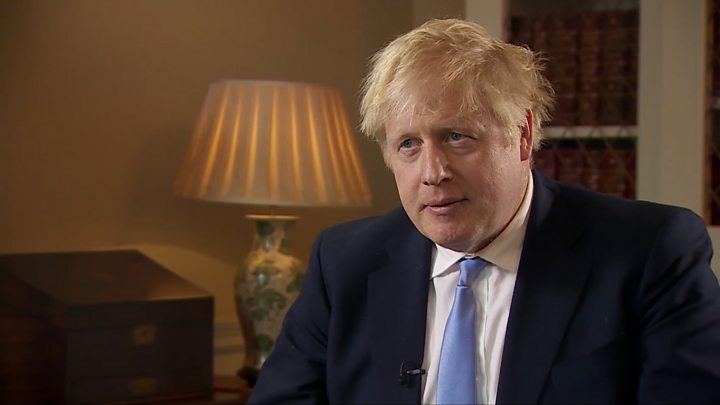
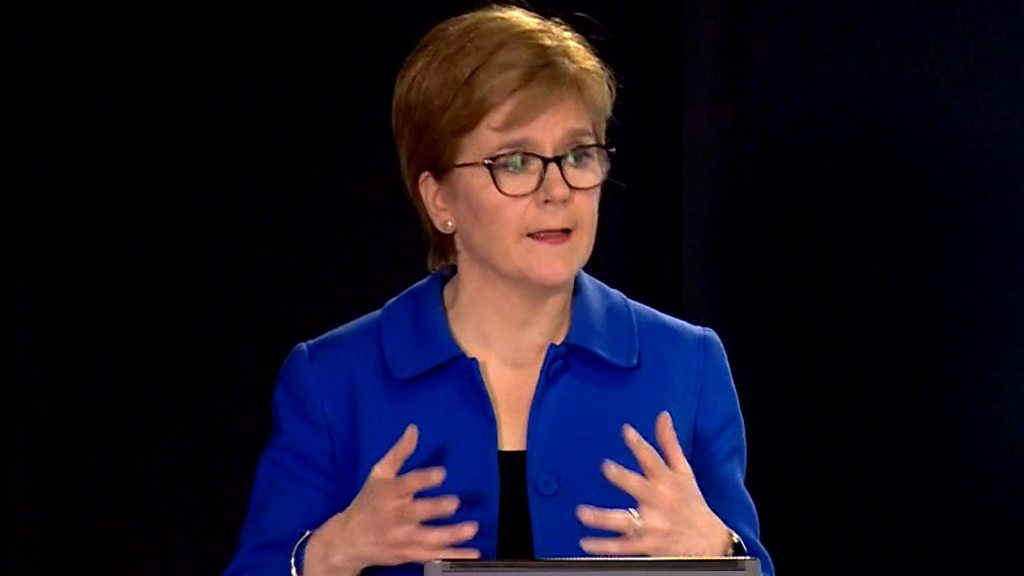
Scotland
Jump to navigationJump to search
|
Scotland
Alba (Scottish Gaelic)
|
|
|---|---|
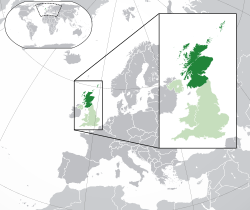
|
|
| Status | Country |
| Capital | Edinburgh 55°57′11″N 3°11′20″W 55°57′11″N 3°11′20″W |
| Largest city | Glasgow |
| Languages | English |
|
Recognised languages[c]
|
|
| Ethnic groups
(2011)
|
|
| Religion | Church of Scotland Roman Catholic Other Christian Islam Hinduism Buddhism Sikhism Judaism Other No religion[7][8] |
| Demonym(s) | |
| Government | Devolved parliamentary legislature within a constitutional monarchy[e] |
|
• Monarch
|
Elizabeth II |
| Nicola Sturgeon | |
| John Swinney | |
| Parliament of the United Kingdom | |
| • Secretary of State | Alister Jack |
| • House of Commons | 59 MPs (of 650) |
| Legislature | Scottish Parliament |
| Formation | |
| 9th century (traditionally 843) | |
| 1 May 1707 | |
| 19 November 1998 | |
| Area | |
|
• Land
|
77,933 km2 (30,090 sq mi)[9] |
|
• Water (%)
|
3.00% |
| Population | |
|
• 2019 estimate
|
|
|
• 2011 census
|
5,313,600[11] |
|
• Density
|
67.5/km2 (174.8/sq mi) |
| GVA | 2017 estimate |
| • Total | £138 billion[12] |
| • Per capita | £25,500[12] |
| HDI (2017) | 0.901[13] very high |
| Currency | Pound sterling (GBP; £) |
| Time zone | UTC (Greenwich Mean Time) |
|
• Summer (DST)
|
UTC+1 (British Summer Time) |
| Date format | dd/mm/yyyy (AD) |
| Driving side | left |
| Calling code | +44 |
| ISO 3166 code | GB-SCT |
| Internet TLD | .scot [f] |
|
|
Scotland (Scots: Scotland, Scottish Gaelic: Alba [ˈal̪ˠapə] (![]() listen)) is a country that is part of the United Kingdom. Covering the northern third of the island of Great Britain,[17][18][19] mainland Scotland has a 96 mile (154 km) border with England to the southeast and is otherwise surrounded by the Atlantic Ocean to the north and west, the North Sea to the northeast and the Irish Sea to the south. In addition, Scotland includes more than 790 islands;[20] principally within the Northern Isles and the Hebrides archipelagos.
listen)) is a country that is part of the United Kingdom. Covering the northern third of the island of Great Britain,[17][18][19] mainland Scotland has a 96 mile (154 km) border with England to the southeast and is otherwise surrounded by the Atlantic Ocean to the north and west, the North Sea to the northeast and the Irish Sea to the south. In addition, Scotland includes more than 790 islands;[20] principally within the Northern Isles and the Hebrides archipelagos.
The Kingdom of Scotland emerged as an independent sovereign state in the European Early Middle Ages and continued to exist until 1707. By inheritance in 1603, James VI of Scotland became king of England and Ireland, thus forming a personal union of the three kingdoms. Scotland subsequently entered into a political union with the Kingdom of England on 1 May 1707 to create the new Kingdom of Great Britain.[21][22] The union also created a new Parliament of Great Britain, which succeeded both the Parliament of Scotland and the Parliament of England. In 1801, the Kingdom of Great Britain entered into a political union with the Kingdom of Ireland to create the United Kingdom of Great Britain and Ireland, (in 1922, the Irish Free State seceded from the United Kingdom, leading to the latter being officially renamed the United Kingdom of Great Britain and Northern Ireland in 1927).[23]
Within Scotland, the monarchy of the United Kingdom has continued to use a variety of styles, titles and other royal symbols of statehood specific to the pre-union Kingdom of Scotland. The legal system within Scotland has also remained separate from those of England and Wales and Northern Ireland; Scotland constitutes a distinct jurisdiction in both public and private law.[24] The continued existence of legal, educational, religious and other institutions distinct from those in the remainder of the UK have all contributed to the continuation of Scottish culture and national identity since the 1707 union with England.[25]
In 1999, a Scottish Parliament was re-established, in the form of a devolved unicameral legislature comprising 129 members, having authority over many areas of domestic policy.[26] The head of the Scottish Government is the first minister of Scotland, who is supported by the deputy first minister of Scotland.[27] Scotland is represented in the United Kingdom Parliament by 59 MPs. Scotland is also a member of the British–Irish Council,[28] sending five members of the Scottish Parliament to the British–Irish Parliamentary Assembly.[29]
Scotland is divided into 32 administrative subdivisions or local authorities, known as council areas.[30] Glasgow City is the largest council area in terms of population, with Highland being the largest in terms of area. Limited self-governing power, covering matters such as education, social services and roads and transportation, is devolved from the Scottish Government to each subdivision.[30]
Etymology
“Scotland” comes from Scoti, the Latin name for the Gaels. Philip Freeman has speculated on the likelihood of a group of raiders adopting a name from an Indo-European root, *skot, citing the parallel in Greek skotos (σκότος), meaning “darkness, gloom”.[31] The Late Latin word Scotia (“land of the Gaels”) was initially used to refer to Ireland.[32] By the 11th century at the latest, Scotia was being used to refer to (Gaelic-speaking) Scotland north of the River Forth, alongside Albania or Albany, both derived from the Gaelic Alba.[33] The use of the words Scots and Scotland to encompass all of what is now Scotland became common in the Late Middle Ages.[21]
History
Early history
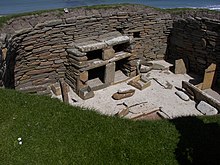
The exposed interior of a house at Skara Brae
Repeated glaciations, which covered the entire land mass of modern Scotland, destroyed any traces of human habitation that may have existed before the Mesolithic period. It is believed the first post-glacial groups of hunter-gatherers arrived in Scotland around 12,800 years ago, as the ice sheet retreated after the last glaciation.[34] At the time, Scotland was covered in forests, had more bog-land, and the main form of transport was by water.[35]:9 These settlers began building the first known permanent houses on Scottish soil around 9,500 years ago, and the first villages around 6,000 years ago. The well-preserved village of Skara Brae on the mainland of Orkney dates from this period. Neolithic habitation, burial, and ritual sites are particularly common and well preserved in the Northern Isles and Western Isles, where a lack of trees led to most structures being built of local stone.[36] Evidence of sophisticated pre-Christian belief systems is demonstrated by sites such as the Callanish Stones on Lewis and the Maes Howe on Orkney, which were built in the third millennium BCE.[37]:38
The first written reference to Scotland was in 320 BC by Greek sailor Pytheas, who called the northern tip of Britain “Orcas”, the source of the name of the Orkney islands.[35]:10 During the first millennium BCE, the society changed dramatically to a chiefdom model, as consolidation of settlement led to the concentration of wealth and underground stores of surplus food.[35]:11 The first Roman incursion into Scotland occurred in 79 AD, when Agricola invaded Scotland; he defeated a Caledonian army at the Battle of Mons Graupius in 83 AD.[35]:12 After the Roman victory, Roman forts were briefly set along the Gask Ridge close to the Highland line, but by three years after the battle, the Roman armies had withdrawn to the Southern Uplands.[38] The Romans erected Hadrian’s Wall in northern England[35]:12 and the Limes Britannicus became the northern border of the Roman Empire.[39][40] The Roman influence on the southern part of the country was considerable, and they introduced Christianity to Scotland.[35]:13–14[37]:38
Middle Ages
Beginning in the sixth century, the area that is now Scotland was divided into three areas: Pictland, a patchwork of small lordships in central Scotland;[35]:25–26 the Anglo-Saxon Kingdom of Northumbria, which had conquered southeastern Scotland;[35]:18–20 and Dál Riata, founded by settlers from Ireland, bringing Gaelic language and culture with them.[35]:20 These societies were based on the family unit and had sharp divisions in wealth, although the vast majority were poor and worked full-time in subsistence agriculture. The Picts kept slaves (mostly captured in war) through the ninth century.[35]:26–27
Gaelic influence over Pictland and Northumbria was facilitated by the large number of Gaelic-speaking clerics working as missionaries.[35]:23–24 Operating in the sixth century on the island of Iona, Saint Columba was one of the earliest and best-known missionaries.[37]:39 The Vikings began to raid Scotland in the eighth century. Although the raiders sought slaves and luxury items, their main motivation was to acquire land. The oldest Norse settlements were in northwest Scotland, but they eventually conquered many areas along the coast. Old Norse entirely displaced Gaelic in the Northern Isles.[35]:29–30
In the ninth century, the Norse threat allowed a Gael named Cináed mac Ailpín (Kenneth I) to seize power over Pictland, establishing a royal dynasty to which the modern monarchs trace their lineage, and marking the beginning of the end of Pictish culture.[35]:31–32[41] The kingdom of Cináed and his descendants, called Alba, was Gaelic in character but existed on the same area as Pictland. By the end of the tenth century, the Pictish language went extinct as its speakers shifted to Gaelic.[35]:32–33 From a base in eastern Scotland north of the River Forth and south of the River Spey, the kingdom expanded first southwards, into the former Northumbrian lands, and northwards into Moray.[35]:34–35 Around the turn of the millennium, there was a centralization in agricultural lands and the first towns began to be established.[35]:36–37
In the twelfth and thirteenth centuries, with much of Scotland under the control of a single ruler and united by the Gaelic language, a modern nation-state first emerged, as did Scottish national consciousness.[42]:38 The domination of Gaelic was diminished during the reign of David I (1124–53), during which many English-speaking colonists settled in Scotland.[42]:39 David I and his successors centralized royal power[42]:41–42 and united mainland Scotland, capturing regions such as Moray, Galloway, and Caithness, although he did not succeed at extending his power over the Hebrides, which had been ruled by various Scottish clans following the death of Somerled in 1164.[42]:48–49 The system of feudalism was consolidated, with both Anglo-Norman incomers and native Gaelic chieftains being granted land in exchange for serving the king.[42]:53–54 The Scottish kings rejected English demands to subjugate themselves; in fact, England invaded Scotland several times to prevent Scotland’s expansion into northern England.[42]:45

The Wallace Monument commemorates William Wallace, the 13th-century Scottish hero.
The death of Alexander III in March 1286 broke the succession line of Scotland’s kings. Edward I of England arbitrated between various claimants for the Scottish crown. In return for surrendering Scotland’s nominal independence, John Balliol was pronounced king in 1292.[42]:47[43] In 1294, Balliol and other Scottish lords refused Edward’s demands to serve in his army against the French. Scotland and France sealed a treaty on 23 October 1295, known as the Auld Alliance. War ensued, and John was deposed by Edward who took personal control of Scotland. Andrew Moray and William Wallace initially emerged as the principal leaders of the resistance to English rule in the Wars of Scottish Independence,[44] until Robert the Bruce was crowned king of Scotland in 1306.[45] Victory at the Battle of Bannockburn in 1314 proved the Scots had regained control of their kingdom. In 1320 the world’s first documented declaration of independence, the Declaration of Arbroath, won the support of Pope John XXII, leading to the legal recognition of Scottish sovereignty by the English Crown. [46]:70, 72
A civil war between the Bruce dynasty and their long-term Comyn-Balliol rivals lasted until the middle of the 14th century. Although the Bruce faction was successful, David II’s lack of an heir allowed his half-nephew Robert II to come to the throne and establish the House of Stewart.[46]:77 The Stewarts ruled Scotland for the remainder of the Middle Ages. The country they ruled experienced greater prosperity from the end of the 14th century through the Scottish Renaissance to the Reformation,[47]:93 despite the effects of the Black Death in 1349[46]:76 and increasing division between Highlands and Lowlands.[46]:78 Multiple truces reduced warfare on the southern border.[46]:76, 83
Early modern period

James VI succeeded to the English and Irish thrones in 1603.
The Treaty of Perpetual Peace was signed in 1502 by James IV of Scotland and Henry VII of England. James married Henry’s daughter, Margaret Tudor.[48] James invaded England in support of France under the terms of the Auld Alliance and became the last British monarch to die in battle, at Flodden in 1513.[49] In 1560, the Treaty of Edinburgh brought an end to the Anglo-French conflict and recognized the Protestant Elizabeth I as Queen of England.[47]:112 The Parliament of Scotland met and immediately adopted the Scots Confession, which signaled the Scottish Reformation‘s sharp break from papal authority and Catholic teaching.[37]:44 The Catholic Mary, Queen of Scots was forced to abdicate in 1567.[50]
In 1603, James VI, King of Scots inherited the thrones of the Kingdom of England and the Kingdom of Ireland in the Union of the Crowns, and moved to London.[51] The military was strengthened, allowing the imposition of royal authority on the western Highland clans. The 1609 Statutes of Iona compelled the cultural integration of Hebridean clan leaders.[52]:37–40 With the exception of a short period under the Protectorate, Scotland remained a separate state, but there was considerable conflict between the crown and the Covenanters over the form of church government.[53]:124 The Glorious Revolution of 1688–89 saw the overthrow of King James VII of Scotland and II of England by the English Parliament in favour of William III and Mary II.[53]:142
The Battle of Altimarlach in 1680 was the last significant clan battle fought between highland clans.[54] In common with countries such as France, Norway, Sweden and Finland, Scotland experienced famines during the 1690s. Mortality, reduced childbirths and increased emigration reduced the population of parts of the country about 10–15%.[55]
In 1698, the Company of Scotland attempted a project to secure a trading colony on the Isthmus of Panama. Almost every Scottish landowner who had money to spare is said to have invested in the Darien scheme. Its failure bankrupted these landowners, but not the burghs. Nevertheless, the nobles’ bankruptcy, along with the threat of an English invasion, played a leading role in convincing the Scots elite to back a union with England.[56][57]
On 22 July 1706, the Treaty of Union was agreed between representatives of the Scots Parliament and the Parliament of England. The following year, twin Acts of Union were passed by both parliaments to create the united Kingdom of Great Britain with effect from 1 May 1707[22] with popular opposition and anti-union riots in Edinburgh, Glasgow, and elsewhere.[58][59]
18th century
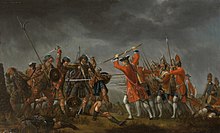
David Morier’s depiction of the Battle of Culloden
With trade tariffs with England abolished, trade blossomed, especially with Colonial America. The clippers belonging to the Glasgow Tobacco Lords were the fastest ships on the route to Virginia. Until the American War of Independence in 1776, Glasgow was the world’s premier tobacco port, dominating world trade.[60] The disparity between the wealth of the merchant classes of the Scottish Lowlands and the ancient clans of the Scottish Highlands grew, amplifying centuries of division.
The deposed Jacobite Stuart claimants had remained popular in the Highlands and north-east, particularly amongst non-Presbyterians, including Roman Catholics and Episcopalian Protestants. However, two major Jacobite risings launched in 1715 and 1745 failed to remove the House of Hanover from the British throne. The threat of the Jacobite movement to the United Kingdom and its monarchs effectively ended at the Battle of Culloden, Great Britain’s last pitched battle.
The Scottish Enlightenment and the Industrial Revolution turned Scotland into an intellectual, commercial and industrial powerhouse[61] – so much so Voltaire said “We look to Scotland for all our ideas of civilisation.”[62] With the demise of Jacobitism and the advent of the Union, thousands of Scots, mainly Lowlanders, took up numerous positions of power in politics, civil service, the army and navy, trade, economics, colonial enterprises and other areas across the nascent British Empire. Historian Neil Davidson notes “after 1746 there was an entirely new level of participation by Scots in political life, particularly outside Scotland.” Davidson also states “far from being ‘peripheral’ to the British economy, Scotland – or more precisely, the Lowlands – lay at its core.”[63]
In the Highlands, clan chiefs gradually started to think of themselves more as commercial landlords than leaders of their people. These social and economic changes included the first phase of the Highland Clearances and, ultimately, the demise of clanship.[64]:32–53, passim
19th century

Shipping on the Clyde, by John Atkinson Grimshaw, 1881
The Scottish Reform Act 1832 increased the number of Scottish MPs and widened the franchise to include more of the middle classes.[65] From the mid-century, there were increasing calls for Home Rule for Scotland and the post of Secretary of State for Scotland was revived.[66] Towards the end of the century Prime Ministers of Scottish descent included William Gladstone,[67] and the Earl of Rosebery.[68] In the late 19th century the growing importance of the working classes was marked by Keir Hardie‘s success in the Mid Lanarkshire by-election, 1888, leading to the foundation of the Scottish Labour Party, which was absorbed into the Independent Labour Party in 1895, with Hardie as its first leader.[69]
Glasgow became one of the largest cities in the world and known as “the Second City of the Empire” after London.[70] After 1860 the Clydeside shipyards specialised in steamships made of iron (after 1870, made of steel), which rapidly replaced the wooden sailing vessels of both the merchant fleets and the battle fleets of the world. It became the world’s pre-eminent shipbuilding centre.[71] The industrial developments, while they brought work and wealth, were so rapid that housing, town-planning, and provision for public health did not keep pace with them, and for a time living conditions in some of the towns and cities were notoriously bad, with overcrowding, high infant mortality, and growing rates of tuberculosis.[72]
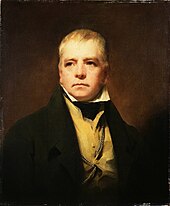
Walter Scott, whose Waverley Novels helped define Scottish identity in the 19th century
While the Scottish Enlightenment is traditionally considered to have concluded toward the end of the 18th century,[73] disproportionately large Scottish contributions to British science and letters continued for another 50 years or more, thanks to such figures as the physicists James Clerk Maxwell and Lord Kelvin, and the engineers and inventors James Watt and William Murdoch, whose work was critical to the technological developments of the Industrial Revolution throughout Britain.[74] In literature, the most successful figure of the mid-19th century was Walter Scott. His first prose work, Waverley in 1814, is often called the first historical novel.[75] It launched a highly successful career that probably more than any other helped define and popularise Scottish cultural identity.[76] In the late 19th century, a number of Scottish-born authors achieved international reputations, such as Robert Louis Stevenson, Arthur Conan Doyle, J. M. Barrie and George MacDonald.[77] Scotland also played a major part in the development of art and architecture. The Glasgow School, which developed in the late 19th century, and flourished in the early 20th century, produced a distinctive blend of influences including the Celtic Revival the Arts and Crafts movement, and Japonism, which found favour throughout the modern art world of continental Europe and helped define the Art Nouveau style. Proponents included architect and artist Charles Rennie Mackintosh.[78]
This period saw a process of rehabilitation for Highland culture. In the 1820s, as part of the Romantic revival, tartan and the kilt were adopted by members of the social elite, not just in Scotland, but across Europe,[79][80] prompted by the popularity of Macpherson’s Ossian cycle[81][82] and then Walter Scott’s Waverley novels.[83] However, the Highlands remained poor, the only part of mainland Britain to continue to experience recurrent famine, with a limited range of products exported out of the region, negligible industrial production, but a continued population growth that tested the subsistence agriculture. These problems, and the desire to improve agriculture and profits were the driving forces of the ongoing Highland Clearances, in which many of the population of the Highlands suffered eviction as lands were enclosed, principally so that they could be used for sheep farming. The first phase of the clearances followed patterns of agricultural change throughout Britain. The second phase was driven by overpopulation, the Highland Potato Famine and the collapse of industries that had relied on the wartime economy of the Napoleonic Wars.[84] The population of Scotland grew steadily in the 19th century, from 1,608,000 in the census of 1801 to 2,889,000 in 1851 and 4,472,000 in 1901.[85] Even with the development of industry, there were not enough good jobs. As a result, during the period 1841–1931, about 2 million Scots migrated to North America and Australia, and another 750,000 Scots relocated to England.[86]
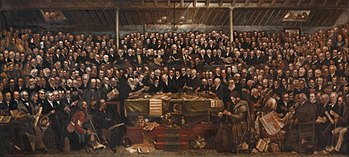
The Disruption Assembly; painted by David Octavius Hill
After prolonged years of struggle in the Kirk, in 1834 the Evangelicals gained control of the General Assembly and passed the Veto Act, which allowed congregations to reject unwanted “intrusive” presentations to livings by patrons. The following “Ten Years’ Conflict” of legal and political wrangling ended in defeat for the non-intrusionists in the civil courts. The result was a schism from the church by some of the non-intrusionists led by Dr Thomas Chalmers, known as the Great Disruption of 1843. Roughly a third of the clergy, mainly from the North and Highlands, formed the separate Free Church of Scotland.[87] In the late 19th century growing divisions between fundamentalist Calvinists and theological liberals resulted in a further split in the Free Church as the rigid Calvinists broke away to form the Free Presbyterian Church in 1893.[88] Catholic emancipation in 1829 and the influx of large numbers of Irish immigrants, particularly after the famine years of the late 1840s, mainly to the growing lowland centres like Glasgow, led to a transformation in the fortunes of Catholicism. In 1878, despite opposition, a Roman Catholic ecclesiastical hierarchy was restored to the country, and Catholicism became a significant denomination within Scotland.[88]
Industrialisation, urbanisation and the Disruption of 1843 all undermined the tradition of parish schools. From 1830 the state began to fund buildings with grants; then from 1846 it was funding schools by direct sponsorship; and in 1872 Scotland moved to a system like that in England of state-sponsored largely free schools, run by local school boards.[89] The historic University of Glasgow became a leader in British higher education by providing the educational needs of youth from the urban and commercial classes, as opposed to the upper class.[90] The University of St Andrews pioneered the admission of women to Scottish universities. From 1892 Scottish universities could admit and graduate women and the numbers of women at Scottish universities steadily increased until the early 20th century.[91]
Caused by the advent of refrigeration and imports of lamb, mutton and wool from overseas, the 1870s brought with them a collapse of sheep prices and an abrupt halt in the previous sheep farming boom.[92] Land prices subsequently plummeted, too, and accelerated the process of the so-called “Balmoralisation” of Scotland, an era in the second half of the 19th century that saw an increase in tourism and the establishment of large estates dedicated to field sports like deer stalking and grouse shooting, especially in the Scottish Highlands.[92][93] The process was named after Balmoral Estate, purchased by Queen Victoria in 1848, that fueled the romanticisation of upland Scotland and initiated an influx of the newly wealthy acquiring similar estates in the following decades.[92][93] In the late 19th century just 118 people owned half of Scotland, with nearly 60 per cent of the whole country being part of shooting estates.[92] While their relative importance has somewhat declined due to changing recreational interests throughout the 20th century, deer stalking and grouse shooting remain of prime importance on many private estates in Scotland.[92]
Early 20th century

Douglas Haig and Ferdinand Foch inspecting the Gordon Highlanders, 1918
Scotland played a major role in the British effort in the First World War. It especially provided manpower, ships, machinery, fish and money.[94] With a population of 4.8 million in 1911, Scotland sent over half a million men to the war, of whom over a quarter died in combat or from disease, and 150,000 were seriously wounded.[95] Field Marshal Sir Douglas Haig was Britain’s commander on the Western Front.
The war saw the emergence of a radical movement called “Red Clydeside” led by militant trades unionists. Formerly a Liberal stronghold, the industrial districts switched to Labour by 1922, with a base among the Irish Catholic working-class districts. Women were especially active in building neighbourhood solidarity on housing issues. However, the “Reds” operated within the Labour Party and had little influence in Parliament and the mood changed to passive despair by the late 1920s.[96]
The shipbuilding industry expanded by a third and expected renewed prosperity, but instead, a serious depression hit the economy by 1922 and it did not fully recover until 1939. The interwar years were marked by economic stagnation in rural and urban areas, and high unemployment.[97] Indeed, the war brought with it deep social, cultural, economic, and political dislocations. Thoughtful Scots pondered their declension, as the main social indicators such as poor health, bad housing, and long-term mass unemployment, pointed to terminal social and economic stagnation at best, or even a downward spiral. Service abroad on behalf of the Empire lost its allure to ambitious young people, who left Scotland permanently. The heavy dependence on obsolescent heavy industry and mining was a central problem, and no one offered workable solutions. The despair reflected what Finlay (1994) describes as a widespread sense of hopelessness that prepared local business and political leaders to accept a new orthodoxy of centralised government economic planning when it arrived during the Second World War.[98]
During the Second World War, Scotland was targeted by Nazi Germany largely due to its factories, shipyards, and coal mines.[99] Cities such as Glasgow and Edinburgh were targeted by German bombers, as were smaller towns mostly located in the central belt of the country.[99] Perhaps the most significant air-raid in Scotland was the Clydebank Blitz of March 1941, which intended to destroy naval shipbuilding in the area.[100] 528 people were killed and 4,000 homes totally destroyed.[100]

Rudolf Hess, Deputy Führer of Nazi Germany, crashed his plane at Bonnyton Moor in the Scottish central belt in an attempt to make peace.
Perhaps Scotland’s most unusual wartime episode occurred in 1941 when Rudolf Hess flew to Renfrewshire, possibly intending to broker a peace deal through the Duke of Hamilton.[101] Before his departure from Germany, Hess had given his adjutant, Karlheinz Pintsch, a letter addressed to Hitler that detailed his intentions to open peace negotiations with the British. Pintsch delivered the letter to Hitler at the Berghof around noon on 11 May.[102] Albert Speer later said Hitler described Hess’s departure as one of the worst personal blows of his life, as he considered it a personal betrayal.[103] Hitler worried that his allies, Italy and Japan, would perceive Hess’s act as an attempt by Hitler to secretly open peace negotiations with the British.

Royal Scots with a captured Japanese Hinomaru Yosegaki flag, Burma, 1945
As in World War I, Scapa Flow in Orkney served as an important Royal Navy base. Attacks on Scapa Flow and Rosyth gave RAF fighters their first successes downing bombers in the Firth of Forth and East Lothian.[104] The shipyards and heavy engineering factories in Glasgow and Clydeside played a key part in the war effort, and suffered attacks from the Luftwaffe, enduring great destruction and loss of life.[105] As transatlantic voyages involved negotiating north-west Britain, Scotland played a key part in the battle of the North Atlantic.[106] Shetland‘s relative proximity to occupied Norway resulted in the Shetland bus by which fishing boats helped Norwegians flee the Nazis, and expeditions across the North Sea to assist resistance.[107]
Scottish industry came out of the depression slump by a dramatic expansion of its industrial activity, absorbing unemployed men and many women as well. The shipyards were the centre of more activity, but many smaller industries produced the machinery needed by the British bombers, tanks and warships.[105] Agriculture prospered, as did all sectors except for coal mining, which was operating mines near exhaustion. Real wages, adjusted for inflation, rose 25% and unemployment temporarily vanished. Increased income, and the more equal distribution of food, obtained through a tight rationing system, dramatically improved the health and nutrition.
Modern day
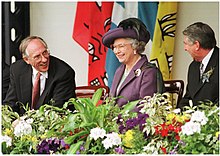
The official reconvening of the Scottish Parliament in July 1999 with Donald Dewar, then first minister of Scotland (left) with Queen Elizabeth II (centre) and Presiding Officer Sir David Steel (right)
After 1945, Scotland’s economic situation worsened due to overseas competition, inefficient industry, and industrial disputes.[108] Only in recent decades has the country enjoyed something of a cultural and economic renaissance. Economic factors contributing to this recovery included a resurgent financial services industry, electronics manufacturing, (see Silicon Glen),[109] and the North Sea oil and gas industry.[110] The introduction in 1989 by Margaret Thatcher’s government of the Community Charge (widely known as the Poll Tax) one year before the rest of Great Britain,[111] contributed to a growing movement for Scottish control over domestic affairs.[112] Following a referendum on devolution proposals in 1997, the Scotland Act 1998[113] was passed by the UK Parliament, which established a devolved Scottish Parliament and Scottish Government with responsibility for most laws specific to Scotland.[114] The Scottish Parliament was reconvened in Edinburgh on 4 July 1999.[115] The first to hold the office of first minister of Scotland was Donald Dewar, who served until his sudden death in 2000.[116]
The Scottish Parliament Building at Holyrood itself did not open until October 2004, after lengthy construction delays and running over budget.[117] The Scottish Parliament has a form of proportional representation (the additional member system), which normally results in no one party having an overall majority. The pro-independence Scottish National Party led by Alex Salmond achieved this in the 2011 election, winning 69 of the 129 seats available.[118] The success of the SNP in achieving a majority in the Scottish Parliament paved the way for the September 2014 referendum on Scottish independence. The majority voted against the proposition, with 55% voting no to independence.[119] More powers, particularly in relation to taxation, were devolved to the Scottish Parliament after the referendum, following cross-party talks in the Smith Commission.
Geography and natural history
The mainland of Scotland comprises the northern third of the land mass of the island of Great Britain, which lies off the north-west coast of Continental Europe. The total area is 78,772 km2 (30,414 sq mi),[120] comparable to the size of the Czech Republic. Scotland’s only land border is with England, and runs for 96 kilometres (60 mi) between the basin of the River Tweed on the east coast and the Solway Firth in the west. The Atlantic Ocean borders the west coast and the North Sea is to the east. The island of Ireland lies only 21 kilometres (13 mi) from the south-western peninsula of Kintyre;[121] Norway is 305 kilometres (190 mi) to the east and the Faroe Islands, 270 kilometres (168 mi) to the north.
The territorial extent of Scotland is generally that established by the 1237 Treaty of York between Scotland and the Kingdom of England[122] and the 1266 Treaty of Perth between Scotland and Norway.[22] Important exceptions include the Isle of Man, which having been lost to England in the 14th century is now a crown dependency outside of the United Kingdom; the island groups Orkney and Shetland, which were acquired from Norway in 1472;[120] and Berwick-upon-Tweed, lost to England in 1482
The geographical centre of Scotland lies a few miles from the village of Newtonmore in Badenoch.[123] Rising to 1,344 metres (4,409 ft) above sea level, Scotland’s highest point is the summit of Ben Nevis, in Lochaber, while Scotland’s longest river, the River Tay, flows for a distance of 190 kilometres (118 mi).[124][125]
Geology and geomorphology

Looking South over the Quiraing on the Isle of Skye
The whole of Scotland was covered by ice sheets during the Pleistocene ice ages and the landscape is much affected by glaciation. From a geological perspective, the country has three main sub-divisions.
The Highlands and Islands lie to the north and west of the Highland Boundary Fault, which runs from Arran to Stonehaven. This part of Scotland largely comprises ancient rocks from the Cambrian and Precambrian, which were uplifted during the later Caledonian orogeny. It is interspersed with igneous intrusions of a more recent age, remnants of which formed mountain massifs such as the Cairngorms and Skye Cuillins.

The Scottish Highlands, located in the north west of Scotland
A significant exception to the above are the fossil-bearing beds of Old Red Sandstones found principally along the Moray Firth coast. The Highlands are generally mountainous and the highest elevations in the British Isles are found here. Scotland has over 790 islands divided into four main groups: Shetland, Orkney, and the Inner Hebrides and Outer Hebrides. There are numerous bodies of freshwater including Loch Lomond and Loch Ness. Some parts of the coastline consist of machair, a low-lying dune pasture land.
The Central Lowlands is a rift valley mainly comprising Paleozoic formations. Many of these sediments have economic significance for it is here that the coal and iron bearing rocks that fuelled Scotland’s industrial revolution are found. This area has also experienced intense volcanism, Arthur’s Seat in Edinburgh being the remnant of a once much larger volcano. This area is relatively low-lying, although even here hills such as the Ochils and Campsie Fells are rarely far from view.
The Southern Uplands are a range of hills almost 200 kilometres (124 mi) long, interspersed with broad valleys. They lie south of a second fault line (the Southern Uplands fault) that runs from Girvan to Dunbar.[126][127][128] The geological foundations largely comprise Silurian deposits laid down some 400–500 million years ago. The high point of the Southern Uplands is Merrick with an elevation of 843 m (2,766 ft).[21][129][130][131] The Southern Uplands is home to Scotland’s highest village, Wanlockhead (430 m or 1,411 ft above sea level).[128]
Climate

Tiree, one of the sunniest locations in Scotland
The climate of most of Scotland is temperate and oceanic, and tends to be very changeable., As it is warmed by the Gulf Stream from the Atlantic, it has much milder winters (but cooler, wetter summers) than areas on similar latitudes, such as Labrador, southern Scandinavia, the Moscow region in Russia, and the Kamchatka Peninsula on the opposite side of Eurasia. However, temperatures are generally lower than in the rest of the UK, with the coldest ever UK temperature of −27.2 °C (−17.0 °F) recorded at Braemar in the Grampian Mountains, on 11 February 1895.[132] Winter maxima average 6 °C (43 °F) in the Lowlands, with summer maxima averaging 18 °C (64 °F). The highest temperature recorded was 32.9 °C (91.2 °F) at Greycrook, Scottish Borders on 9 August 2003.[133]
The west of Scotland is usually warmer than the east, owing to the influence of Atlantic ocean currents and the colder surface temperatures of the North Sea. Tiree, in the Inner Hebrides, is one of the sunniest places in the country: it had more than 300 hours of sunshine in May 1975.[133] Rainfall varies widely across Scotland. The western highlands of Scotland are the wettest, with annual rainfall in a few places exceeding 3,000 mm (120 in).[134] In comparison, much of lowland Scotland receives less than 800 mm (31 in) annually.[135] Heavy snowfall is not common in the lowlands, but becomes more common with altitude. Braemar has an average of 59 snow days per year,[136] while many coastal areas average fewer than 10 days of lying snow per year.[135]
Flora and fauna

A mountain hare (Lepus timidus) in Findhorn Valley, May 2004
Scotland’s wildlife is typical of the north-west of Europe, although several of the larger mammals such as the lynx, brown bear, wolf, elk and walrus were hunted to extinction in historic times. There are important populations of seals and internationally significant nesting grounds for a variety of seabirds such as gannets.[137] The golden eagle is something of a national icon.[138]
On the high mountain tops, species including ptarmigan, mountain hare and stoat can be seen in their white colour phase during winter months.[139] Remnants of the native Scots pine forest exist[140] and within these areas the Scottish crossbill, the UK’s only endemic bird species and vertebrate, can be found alongside capercaillie, Scottish wildcat, red squirrel and pine marten.[141][142][143] Various animals have been re-introduced, including the white-tailed sea eagle in 1975, the red kite in the 1980s,[144][145] and there have been experimental projects involving the beaver and wild boar. Today, much of the remaining native Caledonian Forest lies within the Cairngorms National Park and remnants of the forest remain at 84 locations across Scotland. On the west coast, remnants of ancient Celtic Rainforest still remain, particularly on the Taynish peninsula in Argyll, these forests are particularly rare due to high rates of deforestation throughout Scottish history.[146][147]
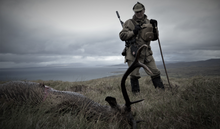
Professional stalker standing next to a red deer stag shot on Ardnamurchan Estate in the Scottish Highlands
The flora of the country is varied incorporating both deciduous and coniferous woodland as well as moorland and tundra species. However, large scale commercial tree planting and the management of upland moorland habitat for the grazing of sheep and field sport activities like deer stalking and driven grouse shooting impacts upon the distribution of indigenous plants and animals.[148] The UK’s tallest tree is a grand fir planted beside Loch Fyne, Argyll in the 1870s, and the Fortingall Yew may be 5,000 years old and is probably the oldest living thing in Europe.[dubious – discuss][149][150][151] Although the number of native vascular plants is low by world standards, Scotland’s substantial bryophyte flora is of global importance.[152][153]
Demographics
The population of Scotland at the 2001 Census was 5,062,011. This rose to 5,295,400, the highest ever, at the 2011 Census.[154] The most recent ONS estimate, for mid-2017, was 5,424,800.[10]
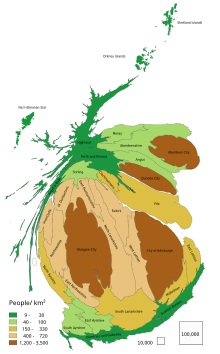
Scotland population cartogram. The size of councils is in proportion to their population.
In the 2011 Census, 62% of Scotland’s population stated their national identity as ‘Scottish only’, 18% as ‘Scottish and British’, 8% as ‘British only’, and 4% chose ‘other identity only’.[155]
Although Edinburgh is the capital of Scotland, the largest city is Glasgow, which has just over 584,000 inhabitants. The Greater Glasgow conurbation, with a population of almost 1.2 million, is home to nearly a quarter of Scotland’s population.[156] The Central Belt is where most of the main towns and cities are located, including Glasgow, Edinburgh, Dundee, and Perth. Scotland’s only major city outside the Central Belt is Aberdeen. The Scottish Lowlands host 80% of the total population, where the Central Belt accounts for 3.5 million people.
In general, only the more accessible and larger islands remain inhabited. Currently, fewer than 90 remain inhabited. The Southern Uplands are essentially rural in nature and dominated by agriculture and forestry.[157][158] Because of housing problems in Glasgow and Edinburgh, five new towns were designated between 1947 and 1966. They are East Kilbride, Glenrothes, Cumbernauld, Livingston, and Irvine.[159]
Immigration since World War II has given Glasgow, Edinburgh, and Dundee small South Asian communities.[160] In 2011, there were an estimated 49,000 ethnically Pakistani people living in Scotland, making them the largest non-White ethnic group.[6] Since the Enlargement of the European Union more people from Central and Eastern Europe have moved to Scotland, and the 2011 census indicated that 61,000 Poles live there.[6][161]
Scotland has three officially recognised languages: English, Scots, and Scottish Gaelic.[162][163] Scottish Standard English, a variety of English as spoken in Scotland, is at one end of a bipolar linguistic continuum, with broad Scots at the other.[164] Scottish Standard English may have been influenced to varying degrees by Scots.[165][166] The 2011 census indicated that 63% of the population had “no skills in Scots”.[167] Others speak Highland English. Gaelic is mostly spoken in the Western Isles, where a large proportion of people still speak it; however, nationally its use is confined to just 1% of the population.[168] The number of Gaelic speakers in Scotland dropped from 250,000 in 1881 to 60,000 in 2008.[169]
There are many more people with Scottish ancestry living abroad than the total population of Scotland. In the 2000 Census, 9.2 million Americans self-reported some degree of Scottish descent.[170] Ulster‘s Protestant population is mainly of lowland Scottish descent,[171] and it is estimated that there are more than 27 million descendants of the Scots-Irish migration now living in the US.[172][173] In Canada, the Scottish-Canadian community accounts for 4.7 million people.[174] About 20% of the original European settler population of New Zealand came from Scotland.[175]
In August 2012, the Scottish population reached an all-time high of 5.25 million people.[176] The reasons given were that, in Scotland, births were outnumbering the number of deaths, and immigrants were moving to Scotland from overseas. In 2011, 43,700 people moved from Wales, Northern Ireland or England to live in Scotland.[176]
The total fertility rate (TFR) in Scotland is below the replacement rate of 2.1 (the TFR was 1.73 in 2011[177]). The majority of births are to unmarried women (51.3% of births were outside of marriage in 2012[178]).
|
Largest cities or towns in Scotland
|
|||||||||
|---|---|---|---|---|---|---|---|---|---|
| Rank | Name | Council area | Pop. | Rank | Name | Council area | Pop. | ||
 Glasgow  Edinburgh |
1 | Glasgow | Glasgow City | 590,507 | 11 | Dunfermline | Fife | 49,706 |  Aberdeen  Dundee |
| 2 | Edinburgh | City of Edinburgh | 459,366 | 12 | Inverness | Highland | 48,201 | ||
| 3 | Aberdeen | Aberdeen City | 195,021 | 13 | Perth | Perth and Kinross | 46,970 | ||
| 4 | Dundee | Dundee City | 147,285 | 14 | Ayr | South Ayrshire | 46,849 | ||
| 5 | Paisley | Renfrewshire | 76,834 | 15 | Kilmarnock | East Ayrshire | 46,159 | ||
| 6 | East Kilbride | South Lanarkshire | 74,395 | 16 | Greenock | Inverclyde | 44,248 | ||
| 7 | Livingston | West Lothian | 56,269 | 17 | Coatbridge | North Lanarkshire | 43,841 | ||
| 8 | Hamilton | South Lanarkshire | 53,188 | 18 | Glenrothes | Fife | 39,277 | ||
| 9 | Cumbernauld | North Lanarkshire | 52,270 | 19 | Airdrie | North Lanarkshire | 37,132 | ||
| 10 | Kirkcaldy | Fife | 49,709 | 20 | Stirling | Stirling | 36,142 | ||
Life expectancy for those born in Scotland between 2012 and 2014 is 77.1 years for males and 81.1 years for females.[180] This is the lowest of any of the four countries of the UK.[180]
Religion

Iona Abbey, an early centre of Christianity in Scotland
Just over half (54%) of the Scottish population reported being a Christian while nearly 37% reported not having a religion in a 2011 census.[181] Since the Scottish Reformation of 1560, the national church (the Church of Scotland, also known as The Kirk) has been Protestant in classification and Reformed in theology. Since 1689 it has had a Presbyterian system of church government and enjoys independence from the state.[21] Its membership is 398,389,[182] about 7.5% of the total population, though according to the 2014 Scottish Annual Household Survey, 27.8%, or 1.5 million adherents, identified the Church of Scotland as the church of their religion.[183] The Church operates a territorial parish structure, with every community in Scotland having a local congregation.
Scotland also has a significant Roman Catholic population, 19% professing that faith, particularly in Greater Glasgow and the north-west.[184] After the Reformation, Roman Catholicism in Scotland continued in the Highlands and some western islands like Uist and Barra, and it was strengthened during the 19th century by immigration from Ireland. Other Christian denominations in Scotland include the Free Church of Scotland, and various other Presbyterian offshoots. Scotland’s third largest church is the Scottish Episcopal Church.[185]
Islam is the largest non-Christian religion (estimated at around 75,000, which is about 1.4% of the population),[181][186] and there are also significant Jewish, Hindu and Sikh communities, especially in Glasgow.[186] The Samyé Ling monastery near Eskdalemuir, which celebrated its 40th anniversary in 2007, is the first Buddhist monastery in western Europe.[187]
Politics and government
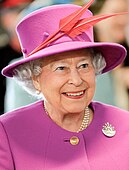 |
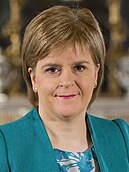 |
| Queen Elizabeth II Monarch |
Nicola Sturgeon First Minister |
The head of state of the United Kingdom is the monarch, currently Queen Elizabeth II (since 1952). The regnal numbering (“Elizabeth II”) caused controversy around the time of her coronation because there had never been an Elizabeth I in Scotland. The British government stated in April 1953 that future British monarchs would be numbered according to either their English or their Scottish predecessors, whichever number would be higher.[188] For instance, any future King James would be styled James VIII—since the last Scottish King James was James VII (also James II of England, etc.)—while the next King Henry would be King Henry IX throughout the UK even though there have been no Scottish kings of that name. A legal action, MacCormick v Lord Advocate (1953 SC 396), was brought in Scotland to contest the right of the Queen to entitle herself “Elizabeth II” within Scotland, but the Crown won the case.[citation needed]
The monarchy of the United Kingdom continues to use a variety of styles, titles and other royal symbols of statehood specific to pre-union Scotland, including: the Royal Standard of Scotland, the Royal coat of arms used in Scotland together with its associated Royal Standard, royal titles including that of Duke of Rothesay, certain Great Officers of State, the chivalric Order of the Thistle and, since 1999, reinstating a ceremonial role for the Crown of Scotland after a 292-year hiatus.[189]
Scotland has limited self-government within the United Kingdom, as well as representation in the UK Parliament. Executive and legislative powers respectively have been devolved to the Scottish Government and the Scottish Parliament at Holyrood in Edinburgh since 1999. The UK Parliament retains control over reserved matters specified in the Scotland Act 1998, including UK taxes, social security, defence, international relations and broadcasting.[190] The Scottish Parliament has legislative authority for all other areas relating to Scotland. It initially had only a limited power to vary income tax,[191] but powers over taxation and social security were significantly expanded by the Scotland Acts of 2012 and 2016.[192]
The Scottish Parliament can give legislative consent over devolved matters back to the UK Parliament by passing a Legislative Consent Motion if United Kingdom-wide legislation is considered more appropriate for a certain issue. The programmes of legislation enacted by the Scottish Parliament have seen a divergence in the provision of public services compared to the rest of the UK. For instance, university education and care services for the elderly are free at point of use in Scotland, while fees are paid in the rest of the UK. Scotland was the first country in the UK to ban smoking in enclosed public places.[193]
The Scottish Parliament is a unicameral legislature with 129 members (MSPs): 73 of them represent individual constituencies and are elected on a first-past-the-post system; the other 56 are elected in eight different electoral regions by the additional member system. MSPs serve for a four-year period (exceptionally five years from 2011–16). The Parliament nominates one of its Members, who is then appointed by the monarch to serve as first minister. Other ministers are appointed by the first minister and serve at his/her discretion. Together they make up the Scottish Government, the executive arm of the devolved government.[194] The Scottish Government is headed by the first minister, who is accountable to the Scottish Parliament and is the minister of charge of the Scottish Government. The first minister is also the political leader of Scotland. The Scottish Government also comprises the deputy first minister, currently John Swinney MSP, who deputises for the first minister during a period of absence of overseas visits. Alongside the deputy first minister’s requirements as Deputy, the minister also has a cabinet ministerial responsibility. Swinney is also currently Cabinet Secretary for Education and Skills.[195] The Scottish Government’s cabinet comprises nine cabinet secretaries, who form the Cabinet of Scotland. There are also twelve other ministers, who work alongside the cabinet secretaries in their appointed areas.[196]
In the 2016 election, the Scottish National Party (SNP) won 63 of the 129 seats available.[197] Nicola Sturgeon, the leader of the SNP, has been the first minister since November 2014.[198] The Conservative Party became the largest opposition party in the 2016 elections, with the Labour Party, Liberal Democrats and the Green Party also represented in the Parliament.[197] The next Scottish Parliament election is due to be held on 6 May 2021.[199]
Scotland is represented in the British House of Commons by 59 MPs elected from territory-based Scottish constituencies. In the 2019 general election, the SNP won 48 of the 59 seats.[200] This represented a significant increase from the 2017 general election, when the SNP won 35 seats.[200][201] Conservative, Labour and Liberal Democrat parties also represent Scottish constituencies in the House of Commons.[200] The next United Kingdom general election is scheduled for 2 May 2024. The Scotland Office represents the UK government in Scotland on reserved matters and represents Scottish interests within the UK government.[202] The Scotland Office is led by the Secretary of State for Scotland, who sits in the Cabinet of the United Kingdom.[203] Conservative MP Alister Jack has held the position since July 2019.[203]
Devolved government relations

British prime minister, Theresa May, and Scottish first minister, Nicola Sturgeon, meeting at Bute House in 2016
The relationships between the central UK Government and devolved governments of Scotland, Wales and Northern Ireland are based on the extra-statutory principles and agreements with the main elements are set out in a Memorandum of Understanding between the UK government and the devolved governments of Scotland, Wales and Northern Ireland. The MOU lays emphasis on the principles of good communication, consultation and co-operation.[204]
Since devolution in 1999, Scotland has devolved stronger working relations across the two other devolved governments, the Welsh Government and Northern Ireland Executive. Whilst there are no formal concordats between the Scottish Government, Welsh Government and Northern Ireland Executive, ministers from each devolved government meet at various points throughout the year at various events such as the British-Irish Council and also meet to discuss matters and issues that are devolved to each government.[205] Scotland, along with the Welsh Government, British Government as well as the Northern Ireland executive, participate in the Joint Ministerial Committee (JMC) which allows each government to discuss policy issues together and work together across each government to find solutions. The Scottish Government considers the successful re-establishment of the Plenary, and establishment of the Domestic fora to be important facets of the relationship with the UK Government and the other devolved administrations.[205]
In the aftermath of the United Kingdom’s decision to withdraw from the European Union in 2016, the Scottish Government has called for there to be a joint approach from each of the devolved governments. In early 2017, the devolved governments met to discuss Brexit and agree on Brexit strategies from each devolved government[206] which lead for Theresa May to issue a statement that claims that the devolved governments will not have a central role or decision making process in the Brexit process, but that the UK Government plans to “fully engage” Scotland in talks alongside the governments of Wales and Northern Ireland.[207]
International diplomacy

First Minister Jack McConnell welcomes President of the United States George W. Bush to Glasgow Prestwick Airport at the start of the G8 Summit in July 2005
Whilst foreign policy remains a reserved matter,[208] the Scottish Government still has the power and ability to strengthen and develop Scotland, the economy and Scottish interests on the world stage and encourage foreign businesses, international devolved, regional and central governments to invest in Scotland.[209] Whilst the first minister usually undertakes a number of foreign and international visits to promote Scotland, international relations, European and Commonwealth relations are also included within the portfolios of both the Cabinet Secretary for Culture, Tourism and External Affairs (responsible for international development)[210] and the Minister for International Development and Europe (responsible for European Union relations and international relations).[211]
During the G8 Summit in 2005, First Minister Jack McConnell welcomed each head of government of the G8 nations to the countries Glasgow Prestwick Airport[212] on behalf of then UK Prime Minister Tony Blair. At the same time, McConnell and the then Scottish Executive pioneered the way forward to launch what would become the Scotland Malawi Partnership which co-ordinates Scottish activities to strengthen existing links with Malawi.[213] During McConnell’s time as first minister, several relations with Scotland, including Scottish and Russian relations strengthened following a visit by President of Russia Vladimir Putin to Edinburgh. McConnell, speaking at the end, highlighted that the visit by Putin was a “post-devolution” step towards “Scotland regaining its international identity”.[214]
Under the Salmond administration, Scotland’s trade and investment deals with countries such as China[215][216] and Canada, where Salmond established the Canada Plan 2010–2015 which aimed to strengthen “the important historical, cultural and economic links” between both Canada and Scotland.[217] To promote Scotland’s interests and Scottish businesses in North America, there is a Scottish Affairs Office located in Washington, D.C. with the aim to promoting Scotland in both the United States and Canada.[218]
During a 2017 visit to the United States, First Minister Nicola Sturgeon met with Jerry Brown, Governor of California, where both signed an agreement committing both the Government of California and the Scottish Government to work together to tackle climate change,[219] as well as Sturgeon signing a £6.3 million deal for Scottish investment from American businesses and firms promoting trade, tourism and innovation.[220] During an official visit to the Republic of Ireland in 2016, Sturgeon claimed that is it “important for Ireland and Scotland and the whole of the British Isles that Ireland has a strong ally in Scotland”.[221] During the same engagement, Sturgeon became the first head of government to address the Seanad Éireann, the Upper House of the Irish Parliament.[221]
Constitutional changes

The debating chamber within the Scottish Parliament Building
A policy of devolution had been advocated by the three main UK parties with varying enthusiasm during recent history. A previous Labour leader. John Smith, described the revival of a Scottish parliament as the “settled will of the Scottish people”.[222] The devolved Scottish Parliament was created after a referendum in 1997 found majority support for both creating the Parliament and granting it limited powers to vary income tax.[223]
The Scottish National Party (SNP), which supports Scottish independence, was first elected to form the Scottish Government in 2007. The new government established a “National Conversation” on constitutional issues, proposing a number of options such as increasing the powers of the Scottish Parliament, federalism, or a referendum on Scottish independence from the United Kingdom. In rejecting the last option, the three main opposition parties in the Scottish Parliament created a commission to investigate the distribution of powers between devolved Scottish and UK-wide bodies.[224] The Scotland Act 2012, based on proposals by the commission, was subsequently enacted devolving additional powers to the Scottish Parliament.[225]
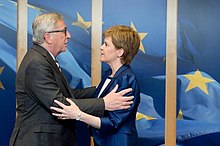
President of the European Commission Jean-Claude Juncker and First Minister Nicola Sturgeon
In August 2009 the SNP proposed a bill to hold a referendum on independence in November 2010. Opposition from all other major parties led to an expected defeat.[226][227][228] After the 2011 elections gave the SNP an overall majority in the Scottish Parliament, a referendum on independence for Scotland was held on 18 September 2014.[229] The referendum resulted in a rejection of independence, by 55.3% to 44.7%.[230][231] During the campaign, the three main parties in the UK Parliament pledged to extend the powers of the Scottish Parliament.[232][233] An all-party commission chaired by Lord Smith of Kelvin was formed,[233] which led to a further devolution of powers through the Scotland Act 2016.[citation needed]
Following a referendum on the UK’s membership of the European Union on 23 June 2016, where a UK-wide majority voted to withdraw from the EU whilst a majority within Scotland voted to remain, Scotland’s first minister, Nicola Sturgeon, announced that as a result a new independence referendum was “highly likely”.[234][235]
Administrative subdivisions
Historical subdivisions of Scotland included the mormaerdom, stewartry, earldom, burgh, parish, county and regions and districts. Some of these names are still sometimes used as geographical descriptors.[citation needed]
Modern Scotland is subdivided in various ways depending on the purpose. In local government, there have been 32 single-tier council areas since 1996,[236] whose councils are responsible for the provision of all local government services. Decisions are made by councillors who are elected at local elections every five years. The head of each council is usually the Lord Provost alongside the Leader of the Council,[237] with a Chief Executive being appointed as director of the council area.[238] Community Councils are informal organisations that represent specific sub-divisions within each council area.[citation needed]
In the Scottish Parliament, there are 73 constituencies and eight regions. For the Parliament of the United Kingdom, there are 59 constituencies. Until 2013, the Scottish fire brigades and police forces were based on a system of regions introduced in 1975. For healthcare and postal districts, and a number of other governmental and non-governmental organisations such as the churches, there are other long-standing methods of subdividing Scotland for the purposes of administration.
City status in the United Kingdom is conferred by letters patent.[239] There are seven cities in Scotland: Aberdeen, Dundee, Edinburgh, Glasgow, Inverness, Stirling and Perth.[240]
Law and criminal justice

High Court of Justiciary, Edinburgh
Scots law has a basis derived from Roman law,[241] combining features of both uncodified civil law, dating back to the Corpus Juris Civilis, and common law with medieval sources. The terms of the Treaty of Union with England in 1707 guaranteed the continued existence of a separate legal system in Scotland from that of England and Wales.[242] Prior to 1611, there were several regional law systems in Scotland, most notably Udal law in Orkney and Shetland, based on old Norse law. Various other systems derived from common Celtic or Brehon laws survived in the Highlands until the 1800s.[243]
Scots law provides for three types of courts responsible for the administration of justice: civil, criminal and heraldic. The supreme civil court is the Court of Session, although civil appeals can be taken to the Supreme Court of the United Kingdom (or before 1 October 2009, the House of Lords). The High Court of Justiciary is the supreme criminal court in Scotland. The Court of Session is housed at Parliament House, in Edinburgh, which was the home of the pre-Union Parliament of Scotland with the High Court of Justiciary and the Supreme Court of Appeal currently located at the Lawnmarket. The sheriff court is the main criminal and civil court, hearing most cases. There are 49 sheriff courts throughout the country.[244] District courts were introduced in 1975 for minor offences and small claims. These were gradually replaced by Justice of the Peace Courts from 2008 to 2010. The Court of the Lord Lyon regulates heraldry.
For three centuries the Scots legal system was unique for being the only national legal system without a parliament. This ended with the advent of the Scottish Parliament in 1999, which legislates for Scotland. Many features within the system have been preserved. Within criminal law, the Scots legal system is unique in having three possible verdicts: “guilty”, “not guilty” and “not proven“.[245] Both “not guilty” and “not proven” result in an acquittal, typically with no possibility of retrial in accordance with the rule of double jeopardy. There is, however, the possibility of a retrial where new evidence emerges at a later date that might have proven conclusive in the earlier trial at first instance, where the person acquitted subsequently admits the offence or where it can be proved that the acquittal was tainted by an attempt to pervert the course of justice – see the provisions of the Double Jeopardy (Scotland) Act 2011. Many laws differ between Scotland and the other parts of the United Kingdom, and many terms differ for certain legal concepts. Manslaughter, in England and Wales, is broadly similar to culpable homicide in Scotland, and arson is called wilful fire raising. Indeed, some acts considered crimes in England and Wales, such as forgery, are not so in Scotland. Procedure also differs. Scots juries, sitting in criminal cases, consist of fifteen jurors, which is three more than is typical in many countries.[246]
The Scottish Prison Service (SPS) manages the prisons in Scotland, which collectively house over 8,500 prisoners.[247] The Cabinet Secretary for Justice is responsible for the Scottish Prison Service within the Scottish Government.
Health care

NHS Scotland‘s Queen Elizabeth University Hospital, Glasgow. It is the largest hospital campus in Europe.[248]
Health care in Scotland is mainly provided by NHS Scotland, Scotland’s public health care system. This was founded by the National Health Service (Scotland) Act 1947 (later repealed by the National Health Service (Scotland) Act 1978) that took effect on 5 July 1948 to coincide with the launch of the NHS in England and Wales. However, even prior to 1948, half of Scotland’s landmass was already covered by state-funded health care, provided by the Highlands and Islands Medical Service.[249] Healthcare policy and funding is the responsibility of the Scottish Government’s Health Directorates. The current Cabinet Secretary for Health and Sport is Jeane Freeman[250] and the Director-General (DG) Health and chief executive, NHS Scotland is Paul Gray.[251]
In 2008, the NHS in Scotland had around 158,000 staff including more than 47,500 nurses, midwives and health visitors and over 3,800 consultants. There are also more than 12,000 doctors, family practitioners and allied health professionals, including dentists, opticians and community pharmacists, who operate as independent contractors providing a range of services within the NHS in return for fees and allowances. These fees and allowances were removed in May 2010, and prescriptions are entirely free, although dentists and opticians may charge if the patient’s household earns over a certain amount, about £30,000 per annum.[252]
Economy
Scotland has a Western-style open mixed economy closely linked with the rest of the UK and the wider world. Traditionally, the Scottish economy was dominated by heavy industry underpinned by shipbuilding in Glasgow, coal mining and steel industries. Petroleum related industries associated with the extraction of North Sea oil have also been important employers from the 1970s, especially in the north-east of Scotland. De-industrialisation during the 1970s and 1980s saw a shift from a manufacturing focus towards a more service-oriented economy.
Scotland’s gross domestic product (GDP), including oil and gas produced in Scottish waters, was estimated at £150 billion for the calendar year 2012.[254] In 2014, Scotland’s per capita GDP was one of the highest in the EU.[255] As of April 2019 the Scottish unemployment rate was 3.3%, below the UK rate of 3.8%, and the Scottish employment rate was 75.9%.[256]
Edinburgh is the financial services centre of Scotland, with many large finance firms based there, including: Lloyds Banking Group (owners of HBOS); the Government-owned Royal Bank of Scotland and Standard Life. Edinburgh was ranked 15th in the list of world financial centres in 2007, but fell to 37th in 2012, following damage to its reputation,[257] and in 2016 was ranked 56th out of 86.[258]
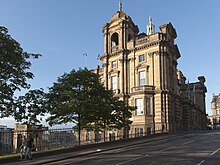
The Bank of Scotland has its headquarters in Edinburgh and is one of the oldest operating banks in the world.
In 2014, total Scottish exports (excluding intra-UK trade) were estimated to be £27.5 billion.[259] Scotland’s primary exports include whisky, electronics and financial services.[260] The United States, Netherlands, Germany, France, and Norway constitute the country’s major export markets.[260]
Whisky is one of Scotland’s more known goods of economic activity. Exports increased by 87% in the decade to 2012[261] and were valued at £4.3 billion in 2013, which was 85% of Scotland’s food and drink exports.[262] It supports around 10,000 jobs directly and 25,000 indirectly.[263] It may contribute £400–682 million to Scotland, rather than several billion pounds, as more than 80% of whisky produced is owned by non-Scottish companies.[264]
A briefing published in 2002 by the Scottish Parliament Information Centre (SPICe) for the Scottish Parliament’s Enterprise and Life Long Learning Committee stated that tourism accounted for up to 5% of GDP and 7.5% of employment.[265]
Currency

A £100 Sterling RBS note
Although the Bank of England is the central bank for the UK, three Scottish clearing banks issue Sterling banknotes: the Bank of Scotland, the Royal Bank of Scotland and the Clydesdale Bank. The value of the Scottish banknotes in circulation in 2013 was £3.8 billion, underwritten by the Bank of England using funds deposited by each clearing bank, under the Banking Act 2009, in order to cover the total value of such notes in circulation.[266]
Military
Of the money spent on UK defence, about £3.3 billion can be attributed to Scotland as of 2013. Although Scotland has a long military tradition predating the Treaty of Union with England, its armed forces now form part of the British Armed Forces, with the exception of the Atholl Highlanders, Europe’s only legal private army. In 2006, the infantry regiments of the Scottish Division were amalgamated to form the Royal Regiment of Scotland. Other distinctively Scottish regiments in the British Army include the Scots Guards, the Royal Scots Dragoon Guards and the 154 (Scottish) Regiment RLC, an Army Reserve Regiment of the Royal Logistic Corps.
Because of their topography and perceived remoteness, parts of Scotland have housed many sensitive defence establishments.[267][268][269] Between 1960 and 1991, the Holy Loch was a base for the US fleet of Polaris ballistic missile submarines.[270] Today, Her Majesty’s Naval Base Clyde, 25 miles (40 kilometres) north-west of Glasgow, is the base for the four Trident-armed Vanguard-class ballistic missile submarines that comprise the UK’s nuclear deterrent. Scapa Flow was the major Fleet base for the Royal Navy until 1956.
A single front-line Royal Air Force base is located in Scotland. RAF Lossiemouth, located in Moray, is the most northerly air defence fighter base in the United Kingdom and is home to three fast-jet squadrons equipped with the Eurofighter Typhoon.
Education
The Scottish education system has always been distinct from the rest of the United Kingdom, with a characteristic emphasis on a broad education.[271] In the 15th century, the Humanist emphasis on education cumulated with the passing of the Education Act 1496, which decreed that all sons of barons and freeholders of substance should attend grammar schools to learn “perfyct Latyne”, resulting in an increase in literacy among a male and wealthy elite.[272] In the Reformation, the 1560 First Book of Discipline set out a plan for a school in every parish, but this proved financially impossible.[273] In 1616 an act in Privy council commanded every parish to establish a school.[274] By the late seventeenth century there was a largely complete network of parish schools in the lowlands, but in the Highlands basic education was still lacking in many areas.[275] Education remained a matter for the church rather than the state until the Education (Scotland) Act 1872.[276]
The Curriculum for Excellence, Scotland’s national school curriculum, presently provides the curricular framework for children and young people from age 3 to 18.[277] All 3- and 4-year-old children in Scotland are entitled to a free nursery place. Formal primary education begins at approximately 5 years old and lasts for 7 years (P1–P7); children in Scotland study Standard Grades, or Intermediate qualifications between the ages of 14 and 16. These are being phased out and replaced by the National Qualifications of the Curriculum for Excellence. The school leaving age is 16, after which students may choose to remain at school and study for Access, Intermediate or Higher Grade and Advanced Higher qualifications. A small number of students at certain private, independent schools may follow the English system and study towards GCSEs and A and AS-Levels instead.[278]
There are fifteen Scottish universities, some of which are amongst the oldest in the world.[vague][279][280] These include the University of St Andrews, the University of Glasgow, the University of Aberdeen and the University of Edinburgh—many of which are ranked amongst the best in the UK.[vague][281][282] Scotland had more universities per capita in QS’ World University Rankings’ top 100 in 2012 than any other nation.[283] The country produces 1% of the world’s published research with less than 0.1% of the world’s population, and higher education institutions account for 9% of Scotland’s service sector exports.[284][285] Scotland’s University Courts are the only bodies in Scotland authorised to award degrees.
Tuition is handled by the Student Awards Agency Scotland (SAAS), which does not charge fees to what it defines as “Young Students”. Young Students are defined as those under 25, without children, marriage, civil partnership or cohabiting partner, who have not been outside of full-time education for more than three years. Fees exist for those outside the young student definition, typically from £1,200 to £1,800 for undergraduate courses, dependent on year of application and type of qualification. Postgraduate fees can be up to £3,400.[286] The system has been in place since 2007 when graduate endowments were abolished.[287] Labour’s education spokesperson Rhona Brankin criticised the Scottish system for failing to address student poverty.[288]
Scotland’s universities are complemented in the provision of Further and Higher Education by 43 colleges. Colleges offer National Certificates, Higher National Certificates, and Higher National Diplomas. These Group Awards, alongside Scottish Vocational Qualifications, aim to ensure Scotland’s population has the appropriate skills and knowledge to meet workplace needs. In 2014, research reported by the Office for National Statistics found that Scotland was the most highly educated country in Europe and among the most well-educated in the world in terms of tertiary education attainment, with roughly 40% of people in Scotland aged 16–64 educated to NVQ level 4 and above.[289][failed verification] Based on the original data for EU statistical regions, all four Scottish regions ranked significantly above the European average for completion of tertiary-level education by 25- to 64-year-olds.[290]
Kilmarnock Academy in East Ayrshire is one of only two schools in the UK, and the only school in Scotland, to have educated two Nobel Prize Laureates – Alexander Fleming, discoverer of Penicillin, and John Boyd Orr, 1st Baron Boyd-Orr, for his scientific research into nutrition and his work as the first Director-General of the United Nations Food and Agriculture Organization (FAO).
Culture
Scottish music
Scottish music is a significant aspect of the nation’s culture, with both traditional and modern influences. A famous traditional Scottish instrument is the Great Highland bagpipe, a wind instrument consisting of three drones and a melody pipe (called the chanter), which are fed continuously by a reservoir of air in a bag. Bagpipe bands, featuring bagpipes and various types of drums, and showcasing Scottish music styles while creating new ones, have spread throughout the world. The clàrsach (harp), fiddle and accordion are also traditional Scottish instruments, the latter two heavily featured in Scottish country dance bands. There are many successful Scottish bands and individual artists in varying styles including Annie Lennox, Amy Macdonald, Runrig, Belle and Sebastian, Boards of Canada, Camera Obscura, Cocteau Twins, Deacon Blue, Franz Ferdinand, Susan Boyle, Emeli Sandé, Texas, The View, The Fratellis, Twin Atlantic and Biffy Clyro. Other Scottish musicians include Shirley Manson, Paolo Nutini, Andy Stewart and Calvin Harris.[291][failed verification]
Literature
Scotland has a literary heritage dating back to the early Middle Ages. The earliest extant literature composed in what is now Scotland was in Brythonic speech in the 6th century, but is preserved as part of Welsh literature.[292] Later medieval literature included works in Latin,[293] Gaelic,[294] Old English[295] and French.[296] The first surviving major text in Early Scots is the 14th-century poet John Barbour‘s epic Brus, focusing on the life of Robert I,[297] and was soon followed by a series of vernacular romances and prose works.[298] In the 16th century, the crown’s patronage helped the development of Scots drama and poetry,[299] but the accession of James VI to the English throne removed a major centre of literary patronage and Scots was sidelined as a literary language.[300] Interest in Scots literature was revived in the 18th century by figures including James Macpherson, whose Ossian Cycle made him the first Scottish poet to gain an international reputation and was a major influence on the European Enlightenment.[301] It was also a major influence on Robert Burns, whom many consider the national poet,[302] and Walter Scott, whose Waverley Novels did much to define Scottish identity in the 19th century.[303] Towards the end of the Victorian era a number of Scottish-born authors achieved international reputations as writers in English, including Robert Louis Stevenson, Arthur Conan Doyle, J. M. Barrie and George MacDonald.[304] In the 20th century the Scottish Renaissance saw a surge of literary activity and attempts to reclaim the Scots language as a medium for serious literature.[305] Members of the movement were followed by a new generation of post-war poets including Edwin Morgan, who would be appointed the first Scots Makar by the inaugural Scottish government in 2004.[306] From the 1980s Scottish literature enjoyed another major revival, particularly associated with a group of writers including Irvine Welsh.[305] Scottish poets who emerged in the same period included Carol Ann Duffy, who, in May 2009, was the first Scot named UK Poet Laureate.[307]
Celtic connections
As one of the Celtic nations, Scotland and Scottish culture are represented at interceltic events at home and over the world. Scotland hosts several music festivals including Celtic Connections (Glasgow), and the Hebridean Celtic Festival (Stornoway). Festivals celebrating Celtic culture, such as Festival Interceltique de Lorient (Brittany), the Pan Celtic Festival (Ireland), and the National Celtic Festival (Portarlington, Australia), feature elements of Scottish culture such as language, music and dance.[308][309][310][311][312][313][314][excessive citations]
National identity

Saint Andrew depicted on a 16th-century coat of arms of the burgh of St. Andrews
The image of St. Andrew, martyred while bound to an X-shaped cross, first appeared in the Kingdom of Scotland during the reign of William I.[315] Following the death of King Alexander III in 1286 an image of Andrew was used on the seal of the Guardians of Scotland who assumed control of the kingdom during the subsequent interregnum.[316] Use of a simplified symbol associated with Saint Andrew, the saltire, has its origins in the late 14th century; the Parliament of Scotland decreeing in 1385 that Scottish soldiers should wear a white Saint Andrew’s Cross on the front and back of their tunics.[317] Use of a blue background for the Saint Andrew’s Cross is said to date from at least the 15th century.[318] Since 1606 the saltire has also formed part of the design of the Union Flag. There are numerous other symbols and symbolic artefacts, both official and unofficial, including the thistle, the nation’s floral emblem (celebrated in the song, The Thistle o’ Scotland), the Declaration of Arbroath, incorporating a statement of political independence made on 6 April 1320, the textile pattern tartan that often signifies a particular Scottish clan and the royal Lion Rampant flag.[319][320][321] Highlanders can thank James Graham, 3rd Duke of Montrose, for the repeal in 1782 of the Act of 1747 prohibiting the wearing of tartans.[322]
Although there is no official national anthem of Scotland,[323] Flower of Scotland is played on special occasions and sporting events such as football and rugby matches involving the Scotland national teams and since 2010 is also played at the Commonwealth Games after it was voted the overwhelming favourite by participating Scottish athletes.[324] Other currently less popular candidates for the National Anthem of Scotland include Scotland the Brave, Highland Cathedral, Scots Wha Hae and A Man’s A Man for A’ That.[citation needed]
St Andrew’s Day, 30 November, is the national day, although Burns’ Night tends to be more widely observed, particularly outside Scotland. In 2006, the Scottish Parliament passed the St Andrew’s Day Bank Holiday (Scotland) Act 2007, designating the day an official bank holiday.[325] Tartan Day is a recent innovation from Canada.[citation needed]
The national animal of Scotland is the unicorn, which has been a Scottish heraldic symbol since the 12th century.[326]
Cuisine
Scottish cuisine has distinctive attributes and recipes of its own but shares much with wider British and European cuisine as a result of local and foreign influences, both ancient and modern. Traditional Scottish dishes exist alongside international foodstuffs brought about by migration. Scotland’s natural larder of game, dairy products, fish, fruit, and vegetables is the chief factor in traditional Scots cooking, with a high reliance on simplicity and a lack of spices from abroad, as these were historically rare and expensive. Irn-Bru is the most common Scottish carbonated soft drink, often described as “Scotland’s other national drink” (after whisky).[327] During the Late Middle Ages and early modern era, French cuisine played a role in Scottish cookery due to cultural exchanges brought about by the “Auld Alliance“,[328] especially during the reign of Mary, Queen of Scots. Mary, on her return to Scotland, brought an entourage of French staff who are considered responsible for revolutionising Scots cooking and for some of Scotland’s unique food terminology.[citation needed]
Media

Scottish inventor John Logie Baird demonstrated the first working television system on 26 January 1926.[329]
National newspapers such as the Daily Record, The Herald, The Scotsman and The National are all produced in Scotland.[330] Important regional dailies include the Evening News in Edinburgh, The Courier in Dundee in the east, and The Press and Journal serving Aberdeen and the north.[330] Scotland is represented at the Celtic Media Festival, which showcases film and television from the Celtic countries. Scottish entrants have won many awards since the festival began in 1980.[331]
Television in Scotland is largely the same as UK-wide broadcasts, however, the national broadcaster is BBC Scotland, a constituent part of the British Broadcasting Corporation, the publicly funded broadcaster of the United Kingdom. It runs three national television stations, and the national radio stations, BBC Radio Scotland and BBC Radio nan Gàidheal, amongst others. Scotland also has some programming in the Gaelic language. BBC Alba is the national Gaelic-language channel. The main Scottish commercial television station is STV which broadcasts on two of the three ITV regions of Scotland.[332]
Scotland has a number of production companies which produce films and television programmes for Scottish, UK and international audiences. Popular films associated with Scotland through Scottish production or being filmed in Scotland include Braveheart (1995),[333] Highlander (1986),[333] Trainspotting (1996),[333] Red Road (2006), Neds (2010),[333] The Angel’s Share (2012), Brave (2012)[334] and Outlaw King (2018).[335] Popular television programmes associated with Scotland include the long running BBC Scotland soap opera River City which has been broadcast since 2002,[336] Still Game, a popular Scottish sitcom broadcast throughout the United Kingdom (2002–2007, revived in 2016),[337] Rab C. Nesbitt, Two Doors Down[338] and Take the High Road.[339]
Wardpark Studios in Cumbernauld is one of Scotland’s television and film production studios where the television programme Outlander is produced.[340] Dumbarton Studios, located in Dumbarton is largely used for BBC Scotland programming, used for the filming and production of television programmes such as Still Game, River City, Two Doors Down, and Shetland.[341]
Sport
Scotland hosts its own national sporting competitions and has independent representation at several international sporting events, including the FIFA World Cup, the Rugby Union World Cup, the Rugby League World Cup, the Cricket World Cup, the Netball World Cup and the Commonwealth Games. Scotland has its own national governing bodies, such as the Scottish Football Association (the second oldest national football association in the world)[342] and the Scottish Rugby Union. Variations of football have been played in Scotland for centuries, with the earliest reference dating back to 1424.[343]
Football
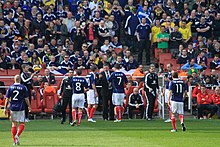
Scotland national football team in competition against Brazil, 2011
The world’s first official international association football match was held in 1872 and was the idea of C. W. Alcock of the Football Association which was seeking to promote Association Football in Scotland.[344][better source needed] The match took place at the West of Scotland Cricket Club‘s Hamilton Crescent ground in the Partick area of Glasgow. The match was between Scotland and England and resulted in a 0–0 draw. Following this, the newly developed football became the most popular sport in Scotland. The Scottish Cup was first contested in 1873. Queen’s Park F.C., in Glasgow, is probably the oldest association football club in the world outside England.[citation needed]
The Scottish Football Association (SFA), the second-oldest national football association in the world, is the main governing body for Scottish association football, and a founding member of the International Football Association Board (IFAB) which governs the Laws of the Game. As a result of this key role in the development of the sport Scotland is one of only four countries to have a permanent representative on the IFAB; the other four representatives being appointed for set periods by FIFA.[citation needed]
The SFA also has responsibility for the Scotland national football team, whose supporters are commonly known as the “Tartan Army“. As of December 2019, Scotland are ranked as the 50th best national football team in the FIFA World Rankings.[345] The national team last attended the World Cup in France in 1998, but finished last in their group stage.[346] The Scotland women’s team have achieved more recent success, qualifying for both Euro 2017[347] and the 2019 World Cup.[348] As of December 2019, they were ranked as the 22nd best women’s national team in the FIFA Rankings.[349]
Scottish clubs have achieved some success in European competitions, with Celtic winning the European Cup in 1967, Rangers and Aberdeen winning the UEFA Cup Winners’ Cup in 1972 and 1983 respectively, and Aberdeen also winning the UEFA Super Cup in 1983. Celtic, Rangers and Dundee United have also reached European finals, the most recent of these being Rangers in 2008.[350]
Golf

The Old Course at St Andrews where golf originates from
With the modern game of golf originating in 15th-century Scotland, the country is promoted as the home of golf.[351][352][353] To many golfers the Old Course in the Fife town of St Andrews, an ancient links course dating to before 1552,[354] is considered a site of pilgrimage.[355] In 1764, the standard 18-hole golf course was created at St Andrews when members modified the course from 22 to 18 holes.[356] The world’s oldest golf tournament, and golf’s first major, is The Open Championship, which was first played on 17 October 1860 at Prestwick Golf Club, in Ayrshire, Scotland, with Scottish golfers winning the earliest majors.[357] There are many other famous golf courses in Scotland, including Carnoustie, Gleneagles, Muirfield, and Royal Troon.
Other sports
Other distinctive features of the national sporting culture include the Highland games, curling and shinty. In boxing, Scotland has had 13 world champions, including Ken Buchanan, Benny Lynch and Jim Watt. Scotland has also been successful in motorsport, particularly in Formula One. Notable drivers include; David Coulthard, Jim Clark, Paul Di Resta, and Jackie Stewart.[358] In IndyCar, Dario Franchitti has won 4 consecutive IndyCar world championships.[359]
Scotland has competed at every Commonwealth Games since 1930 and has won 356 medals in total—91 Gold, 104 Silver and 161 Bronze.[360] Edinburgh played host to the Commonwealth Games in 1970 and 1986, and most recently Glasgow in 2014.[361]
Infrastructure
Energy
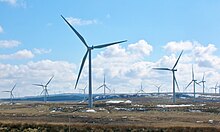
Whitelee Wind Farm is the largest onshore wind farm on the British isles.
Scotland’s primary sources for energy are provided though renewable energy (42%), nuclear (35%) and fossil fuel generation (22%).[362]
The Scottish Government has a target to have the equivalent of 50% of the energy for Scotland’s heat, transport and electricity consumption to be supplied from renewable sources by 2030.[363]
Transport
Air
Scotland has five international airports operating scheduled services to Europe, North America and Asia, as well domestic services to England, Northern Ireland and Wales.
Highlands and Islands Airports operates eleven airports across the Highlands, Orkney, Shetland and the Western Isles, which are primarily used for short distance, public service operations, although Inverness Airport has a number of scheduled flights to destinations across the UK and mainland Europe.
Edinburgh Airport is currently Scotland’s busiest airport handling over 13 million passengers in 2017.[364] It is also the UK’s 6th busiest airport.
British Airways, easyJet, flybe, Jet2, and Ryanair operate the majority of flights between Scotland and other major UK and European airports.
Four airlines are based in Scotland:
Rail
Network Rail owns and operates the fixed infrastructure assets of the railway system in Scotland, while the Scottish Government retains overall responsibility for rail strategy and funding in Scotland.[365] Scotland’s rail network has 359 railway stations and around 1,710 miles (2,760 km) of track.[366] In 2018–19 there were 102 million passenger journies on Scottish railways.[367]
The East Coast and West Coast main railway lines connect the major cities and towns of Scotland with each other and with the rail network in England. London North Eastern Railway provides inter-city rail journeys between Glasgow, Edinburgh, Aberdeen and Inverness to London. Domestic rail services within Scotland are operated by Abellio ScotRail. During the time of British Rail, the West Coast Main Line from London Euston to Glasgow Central was electrified in the early 1970s, followed by the East Coast Main Line in the late 1980s. British Rail created the ScotRail brand. When British Rail existed, many railway lines in Strathclyde were electrified. Strathclyde Passenger Transport Executive was at the forefront with the acclaimed “largest electrified rail network outside London”. Some parts of the network are electrified, but there are no electrified lines in the Highlands, Angus, Aberdeenshire, the cities of Dundee or Aberdeen, or Perth & Kinross, and none of the islands has a rail link (although the railheads at Kyle of Lochalsh and Mallaig principally serve the islands).
The East Coast Main Line crosses the Firth of Forth by the Forth Bridge. Completed in 1890, this cantilever bridge has been described as “the one internationally recognised Scottish landmark”.[368][page needed] Scotland’s rail network is managed by Transport Scotland.[369]
Road
The Scottish motorways and major trunk roads are managed by Transport Scotland. The remainder of the road network is managed by the Scottish local authorities in each of their areas.
Water
Regular ferry services operate between the Scottish mainland and outlying islands. Ferries serving both the inner and outer Hebrides are principally operated by the state-owned enterprise Caledonian MacBrayne.
Services to the Northern Isles are operated by Serco. Other routes, served by multiple companies, connect southwest Scotland to Northern Ireland. DFDS Seaways operated a freight-only Rosyth – Zeebrugge ferry service, until a fire damaged the vessel DFDS were using.[370] A passenger service was also operated between 2002–2010.[371]
Additional routes are operated by local authorities.
-
Air Traffic Control tower of Edinburgh Airport
-
Domestic rail services are operated by Abellio ScotRail.
-
Bilingual (Scottish Gaelic/English) roadsigns are found throughout the Highlands and the Hebrides.
| اسكتلندا | ||
|---|---|---|
|
|
||
|
||
|
|
||

|
||
إحداثيات:  57°N 5°W 57°N 5°W |
||
| تقسيم إداري | ||
| البلد | ||
| التقسيم الأعلى | المملكة المتحدة (6 ديسمبر 1922–) |
|
| العاصمة | إدنبرة |
|
| التقسيمات الإدارية |
جزر أوركني
أبردينشاير أنغوس كلاكمانشاير دومفريز وغالاوي شرق دونبارتونشاير لوثيان الشرقية هبرديس الخارجي هایلند ميدلوثيان بيرث وكينروس ساوث لانركشاير دونبارتونشير الغربية غرب لوثيان شتلاند |
|
| خصائص جغرافية | ||
| • المساحة | 78782 كيلومتر مربع |
|
| عدد السكان | ||
| عدد السكان | 5404700 (2016) |
|
| الكثافة السكانية | 68.60 نسمة/كم2 | |
| معلومات أخرى | ||
| منطقة زمنية | ت ع م±00:00 |
|
| اللغة الرسمية | الإنجليزية |
|
| رمز جيونيمز | 2638360 |
|
| أيزو 3166 | GB-SCT |
|
| الموقع الرسمي | الموقع الرسمي |
|
اِسْكُتْلَنْدَا[5] (تلفظ /iskutˈlanda/ بالعربية) (بالانجليزية: Scotland) دولة في شمال غرب أوروبا، تعتبر جزء من الدول الأربع المكونة المملكة المتحدة. تحتل الثلث الشمالي من جزيرة بريطانيا العظمى وتحدها جنوباً إنجلترا ويحدها شرقاً بحر الشمال وغرباً المحيط الأطلسي. عاصمتها أدنبرة، وأهم مدنها وأكبرها مدينة غلاسكو. كانت اسكتلندا مملكة مستقلة حتى 1 مايو 1707 حين تم إقرار قانون الوحدة لعام 1707 والذي اتحدت بموجبه مملكتي إنجلترا واسكتلندا في ما يعرف اليوم بمملكة بريطانيا العظمى.
التسمية
اسكتلندا تسمى أيضاً ايقوسية[6] أو إسقوسية أو سقوسية وتسميتها اللاتينية القديمة “كاليدونيا” (Caledonia) ولا علاقة لذلك مباشرة باسم “كاليدونيا الجديدة“.
وأصل التسمية أتى من كلمة سكوتي[7] (en) وهي التسمية اللاتينية لشعب الغال[8] والغال اسم أطلقه الرومان على الشعب الذي استوطن تلك الأراضي منذ عصر ما قبل التاريخ
تاريخ
 مقالة مفصلة: تاريخ اسكتلندا
مقالة مفصلة: تاريخ اسكتلندا
كان أول استيطان لاسكتلندا في عام 6000 ق.م، حيث استوطنها بعض صائدي الأسماك وبعض الصيادين المهاجرين الآخرين الذين جاءوها بحرًا من جهة الجنوب. وزاد عدد أولئك المهاجرين إلى اسكتلندا في العصر الحجري الحديث، حيث مارسوا شيءً من الزراعة، دلت عليها آثارهم التي خلفوها، من فخار وعظام وأدوات.
وبنهاية هذا العصر الحجري الحديث، وفدت إلى اسكتلندا مجموعات جديدة، جاءت من ألمانيا، سماها علماء الآثار مجموعة الأواني لأنهم دفنوا موتاهم في قوارير كبيرة أشبه ما تكون بالكؤوس، ثم تلتهم مجموعة مهاجرين قادمة من أواسط أوروبا، هم المعروفون ببناة الأبراج.
وعندما غزا الرومان بريطانيا عام 43م، وجدوا أقوامًا يسكنون أجزاءً من اسكتلندا، هي الجهات الشمالية والجنوبية لنهري كلايد ونهر فورث [الإنجليزية]. وقد أخضعهم الرومان لسلطانهم، وسموهم البكتز (البقط) وكانوا يلونون أجسامهم بالألوان. وفي القرن الرابع الميلادي، هاجر إلى اسكتلندا أقوام من أيرلندا، عرفوا في التاريخ بالإسكتلنديين ونشروا لغتهم المعروفة بالغيلية وثقافتهم. وبانسحاب الرومان من بريطانيا، غزتها أقوام الأنجلو-سكسون، وتمكنوا في بداية القرن السابع الميلادي من احتلال المنطقة الواقعة حول أدنبرة، وكذلك استقر الفايكنج في الأطراف الشمالية من اسكتلندا خلال القرنين الثامن والتاسع الميلاديين.
مطامع إنجلترا
كانت اسكتلندا عرضة للتأثيرات الأنجلو-سكسونية، و الأنجلو ـ نورمندية [الإنجليزية] طوال القرنين العاشر والحادي عشر الميلاديين. ونتج عن التأثيرات النورمندية أن تحولت اسكتلندا إلى دولة إقطاعية ذات إدارة منظمة ونظام مالي راسخ، الأمر الذي ساعد على ازدهارها الزراعي والحضري، وكانت لها علاقات بإنجلترا، كما كانت لها أطماع أيضًا في بعض الأراضي الإنجليزية كمنطقة نورث همبرلاند.
وقد كان لملوك إنجلترا المطامع نفسها في اسكتلندا، بل إن بعضهم نجح في فترات من القرن الثاني عشر الميلادي في جعل مملكة اسكتلندا تابعة لهم. وهكذا كانت العلاقة بين المملكتين في حركة مد وجزْر دائمة. فمثلاً، شهدت السنوات الأخيرة من الثالث عشر الميلادي، وكل سنوات الرابع عشر، محاولات ملوك إنجلترا فرض سيطرتهم على اسكتلندا، وبالمقابل ثورات الإسكتلنديين تحت قيادة زعمائهم المحليين للخلاص من تلك السيطرة الإنجليزية. وقد تحقق لأهل اسكتلندا ما أرادوا، إذ اعترف الإنجليز باستقلالهم في عام 1328م بعد حروب طاحنة.
وباستقلال اسكتلندا، بدأت فترة حكم عائلة ستيوارت الأولى في الفترة (1371 ـ 1488م). شهدت الفترة نفسها ازدهار الأدب الإسكتلندي، وظهور شعراء كبار مثل جون باربر، وهاري الأعمى وآخرين.
ملوك النهضة
تلت هذه الفترة ماعرف بفترة ملوك النهضة ولعل أهمهم جيمس الرابع، وجيمس الخامس، اللذان قاما في مرات عديدة بغزو إنجلترا، كما تعرضا لغزو منها. وكانت تلك الحروب وخيمة على كلتا المملكتين. وقد انحاز جيمس الخامس إلى جانب فرنسا في حربها مع إنجلترا، وتزوج من إحدى النبيلات الفرنسيات، الأمر الذي أدى إلى تزايد النفوذ الفرنسي في البلاط الإسكتلندي وإلى انحياز النبلاء إلى رجال الكنيسة ودعوات الإصلاح الديني أملاً في مقاومة هذا النفوذ. وتطور أمر هذا الإصلاح ليؤدي إلى إعلان اسكتلندا دولة بروتستانتية لا سلطة للبابا على كنيستها وتحميها الملكة ماري ملكة الأسكتلنديين عام 1559م والتي ثار عليها النبلاء وأجبروها على التخلي عن العرش، وأودعوها السجن. ولكنها تمكنت من الهرب إلى إنجلترا طالبة مساندة الملكة إليزابيث الأولى، ولكن هذه بدل أن تعينها سجنتها، ثم قامت بإعدامها عام 1587م، فخلفها ابنها جيمس السادس والذي حكم بفاعلية. وفي عام 1603م، صار ملكًا لإنجلترا، تحت اسم جيمس الأول، بسبب وفاة الملكة الإنجليزية إليزابيث الأولى لأنه كان أقرب أقاربها إليها؛ فورث عرشها.[9]
جغرافيا
تغطي ثلث مجموع منطقة بريطانيا العظمى، كما تتكون من أكثر من 790 جزيرة. يحدها من الشمال والغرب المحيط الأطلسي، ومن الشرق بحر الشمال، جنوب إنجلترا وفي الجنوب الغربي مع القناة الشمالية والبحر الأيرلندي. تغطي الأراضي الإسكتلندية 78.772 كم²، وعدد سكانها يقدر ب 5.116.900 نسمة، الكثافة السكانية تقدر ب65 نسمة لكل كم². العاصمة إدنبره، وتعد غلاسكو هي أكبر مدينة في والتي تضم 20 ٪ من مجموع سكان اسكتلندا.
يشكل نهر تويد وتلال اسكتلندا الشفيوت الحدود الجنوبية مع إنجلترا. وتفصل القناة الشمالية الغربية جنوب غرب اسكتلندا من أيرلندا الشمالية. والساحل الشمالي الغربي يطل على المحيط الأطلسي. ويواجه الشرق بحر الشمال. ويواجه الساحل الشرقي لبحر الشمال، والذي يفصل بين اسكتلندا من البر الرئيسي لأوروبا.
السطح
تشغل اسكتلندا الثلث الشمالي من جزيرة بريطانيا ويمثل نهر تويد وتلال تشيفيوت حدودها الجنوبية مع إنجلترا.
الأقاليم الجغرافية
تنقسم اسكتلندا إلى ثلاثة أقاليم جغرافية هي من الشمال إلى الجنوب:
المرتفعات (إقليم الهايلاند)
إقليم وعر وقاحل تمتد فيه سلسلتان جبليتان هما المرتفعات الشمالية وجبال جرامبيان، وتتخللها حافات تتجه من الشمال الشرقي إلى الجنوب الغربي، ويفصل بينهما وادٍ عميق هو وادي جلن مور ويصل أقصى ارتفاع عند قمة بن نِفِيز 1,343م فوق سطح البحر. ويوجد في المرتفعات نوعان من الأودية: أودية ضيقة شديدة الانحدار وأودية واسعة متموجة، وتخلو المرتفعات من الأشجار، وتصبح أكثر وعورة في اتجاه الغرب، ويعيش معظم سكانها في السهول الساحلية.
الأراضي المنخفضة الوسطى
تخترقها أودية أنهار كلايد وفورث وتاي، وتوجد بها أفضل مزارع اسكتلندا ومواردها المعدنية ويعيش فيها ثلاثة أرباع سكان البلاد.
المرتفعات الجنوبية
تتكون من أراضي خلنجية متموجة تتناثر فيها جروف صخرية. وقمم التلال قاحلة ولكن منحدراتها السفلية تغطيها المراعي التي تربى عليها الأبقار والأغنام. وتنتهي التلال في الجنوب عند مرتفعات تشيفيوت.
الأنهار والبحيرات
يمثل نهر كلايد أهم أنهار اسكتلندا، وقد تم توسيع مجرى النهر وتعميقه ليكون صالحًا للملاحة وتستخدمه السفن حتى غلاسكو، أما نهر تاي فيعد أكبر أنهار البلاد. وتصب معظم أنهار اسكتلندا في خلجان واسعة. وتقع معظم بحيرات اسكتلندا في أودية عميقة في المرتفعات. وأكبر البحيرات بحيرة لومند، وتمتد مجموعة من البحيرات في وادي جلن مور وتربط قنال كاليدونيا هذه البحيرات. وأشهر هذه البحيرات بحيرة نس التي يُعتقد بأن بها حيوانًا خرافيًا. محك
الجزر
تحف باسكتلندا مئات الجزر وتقع مجموعة جزر هبريدز، وهي أكبرها، قبالة الساحل الغربي من البلاد بينما تقع جزر أوركني وشتلاند في شمالي اسكتلندا.
سكان
اشتهر الشعب الإسكتلندي بعلاقاته الأسرية المتينة والتنانير الملونة ومهارته الحربية. لكن رياح التغيير أصابت هذه الجوانب ولم يعد الإسكتلندي الحالي يهتم بها الآن.
السكان أمس واليوم
ينحدر معظم سكان اسكتلندا من المغيرين الذين وفدوا إلى البلاد واستقروا فيها قبل آلاف السنين، وهم يشملون السلتيين والإسكندينافيين والأسكتلنديين. وقد تركت كل مجموعة من هؤلاء أثرها في الحضارة الأسكتلندية.
يبلغ عدد سكان اسكتلندا حوالي خمسة ملايين نسمة، يعيش ثلاثة أرباعهم في المنخفضات الوسطى المزدحمة التي تشكل حوالي سدس مساحة البلاد، بينما يعيش عدد قليل من السكان في المرتفعات الوعرة التي تشكل ثلثي مساحة البلاد في الشمال، وفي المرتفعات الجنوبية. ويعيش نحو 2% من السكان في جزيرتي أوركتي وشتلاند والجزر الغربية.
وفي اسكتلندا عدة مدن يتجاوز سكانها 100,000 نسمة منها غلاسكو، أكبر مدنها، وبها 654,542 نسمة، تليها أدنبرة العاصمة وبها 421,213 نسمة، ومن مدنها الكبيرة أبردين ودندي.
تعاني اسكتلندا هجرة أهلها، إذ يهاجر الآلاف سنويًا بسبب قلة الوظائف، مما استدعى إقامة صناعات جديدة للحد من هذه الظاهرة.
اللغة الرسمية
لاسكتلندا ثلاث لغات رسمية هي الإنجليزية والاسكتلندية والغيلية.[10] معظم السكان يتحدثون الإنجليزية الاسكتلندية (إنجليزية بلكنة اسكتلندية) ويتحدث سكان المناطق غير الحضرية باللغة الاسكتلندية، التي يفضّل البعض تصنيفها كإحدى لهجات الإنجليزية.[11] أما في المرتفعات والجزر الإسكتلندية فيتحدث السكان اللغة الغيلية، وهي لغة كلتية قديمة.
أنماط المعيشة
لا يختلف نمط المعيشة في اسكتلندا كثيرًا عن النمط السائد في المجتمعات الصناعية في المملكة المتحدة، إذ يعمل السكان نهارًا ويقضون الليل في الحانات ومشاهدة البرامج التلفازية التي تبثها هيئة الإذاعة البريطانية وثلاث شركات مستقلة.
يمتلك معظم الإسكتلنديين مزارعهم، وتوجد أراضٍ واسعة في الجنوب يؤَجَّر بعضها للمزارعين، وفي المرتفعات الغربية، يؤجِّر المزارعون قطعًا صغيرة لزراعتها. ونظرًا لبرودة الطقس، يرتدي الإسكتلنديون بِذَلاً ومعاطف مصنوعة من التويد وملابس صوفية مصنوعة محليًا.
تعود معظم التقاليد الأسكتلندية إلى نظام العشائر ومن أهم معالمها الكلتية المربعة النقش؛ إذ لكل عشيرة تصميمها الكلتي الخاص الذي يسمى الطرطان، وهو يستخدم في القمصان وأربطة العنق والملابس الأخرى. وتمثل موسيقى القِرَب تقليدًا شهيرًا في المرتفعات.
الطعام والترفيه
يتسم الطبخ الإسكتلندي بالبساطة. والأكلات المفضلة هي سمك الرنجة والسالمون المدخن ولحم البقر والضأن المشوي والهاغس ودقيق الشوفان.
يستمتع الأسكتلنديون بالهواء الطلق، إذ توجد في بلادهم مناطق مفتوحة واسعة ومتنزهات قومية تغطي 13% من مساحة البلاد. ومن أنواع الرياضة التي يمارسها الأسكتلنديون الجولف وكرة القدم والرجبي. وكذلك سباق العدو والرقص. ويقبل العديد من السياح من كل أنحاء العالم على صيد سمك السالمون والتروتة من النهيرات الجبلية الصافية، كما يمارس الناس التزلج على الجليد وتسلق الجبال والصيد والرماية.
الدين
حسب إحصاءات عام 2011: وُجد أن 54% من السكان مسيحيون، بينما يعتبر 37% أنفسهم بلا دين الكنيسة القومية في اسكتلندا أصبحت بروتيستانتية منذ عام 1560، وتتمتع الكنيسة بالاستقلال عن الدولة، وبعضوية 12% من السكان. في اسكتلندا أيضا نسبة من الكاثوليك، تقدر ب 19% من السكان، خصوصًا في غرب البلاد. وتوجد أعداد أقل من المنتمين لكنائس أخرى، كـ كنيسة اسكتلندا الحرة والكنيسة الأسقفية السكوتلندية
يعد الإسلام أكبر ديانة غير مسيحية في اسكتلندا، ويبلغ عدد المسلمين حوالي 75,000 مسلم (حوالي 1.4% من السكان).[11] كما يعيش في اسكتلندا بعض الأقليات التي تعتنق اليهودية والبوذية والسيخية خصوصاً في غلاسكو.[11]
التعليم
 مقالة مفصلة: التعليم في اسكتلندا
مقالة مفصلة: التعليم في اسكتلندا
ينفصل نظام التعليم في اسكتلندا ويختلف عن النظم المتبعة في باقي أجزاء المملكة المتحدة. وتقوم مصلحة التعليم الأسكتلندي وسلطات تعليمية محلية بالإشراف على المدارس التي يجب على الأطفال ما بين الخامسة والسادسة عشرة من العمر دخولها. ومعظم هذه المدارس حكومية. وحتى السبعينيات، كانت لاسكتلندا مدارس منفصلة للتعليم المهني والأكاديمي ثم تحولت هذه المدارس إلى مدارس شاملة، كما أن هناك ثماني جامعات. وتسمى الشهادة الجامعية الأولية في اسكتلندا بالماجستير MA ومدتها اربع سنوات (وتقابل مايعرف في إنجلترا بالـ Honours) تليها درجة جامعية متوسطة تسمى MSc وتعطى لطلاب العلوم والآداب على السواءوتلى ذلك الدرجات العليا MLitt أو MPhil ثم الدكتوراه.أما في إنجلترا فالشهادة الجامعية الأولية تسمى بالبكالوريوس ومدتها ثلاث سنوات (أو اربع سنوات إذا كانت Honours).
الفنون
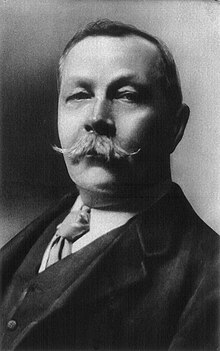
السير آرثر كونان دويل، مؤلف شخصية شرلوك هولمز.
أنجبت اسكتلندا العديد من المشاهير وخاصة في مجال الأدب، ومن شعرائها وأدبائها المشهورين السير آرثر كونان دويل وروبرت برنز والسير والتر سكوت وروبرت لويس ستيفنسون.
سياسة
بالنظر إلى أن اسكتلندا هي واحدة من العناصر المكونة للمملكة المتحدة، ملك المملكة الأسكتلندية هو من عائلة ستيوارت، وهو تابع للملكة اليزابيث الثانية ملكة المملكة المتحدة منذ توليها الملك سنة 1952. ظهرت في القرن التاسع عشر، حركة الاستقلال الإسكتلندي بقيادت ملكها والتي اكتسبت نفوذ منذ نهاية القرن العشرين، يمثلها الملك القومي الإسكتلندي، الذي يدعو لاستقلال اسكتلندا، حصل على أغلبية في التصويت من النبلاء في البرلمان الإسكتلندي في الانتخابات التي جرت في مارس 2007.إن ولقد استحقت اسكتلندا حكما ذاتيا تابعا لحكومة إنجلترا، بمسمى اسكتلندا التابعة للمملكة المتحدة، أو بريطانيا، ولقد تمت الموافقة عليه من قبل هيئة الأمم المتحدة.
دستوريا، المملكة المتحدة هي دولة ذات برلمان موحد وحكومة ذات سيادة. بعد تطبيق اللامركزية في السلطة، والتي تمت الموافقة عليها في استفتاء في عام 1997، رغم أن اسكتلندا تستمتع الآن بحكم ذاتي: البرلمان البريطاني يحتفظ بالقدرة على الإصلاح، والتغيير، تمديد أو إلغاء نظام الحكم في اسكتلندا، يمكن القول أن البرلمان الإسكتلندي ليس ذا سيادة مطلقة.
اقتصاد
 مقالة مفصلة: اقتصاد اسكتلندا
مقالة مفصلة: اقتصاد اسكتلندا
يعتمد اقتصاد اسكتلندا أساسًا على الصناعة والتجارة. وقد اكتسبت الصناعة أهمية منذ بداية الثورة الصناعية في إنجلترا خلال القرن الثامن عشر.
الموارد الطبيعية
لاسكتلندا موارد طبيعية قليلة ماعدا بعض حقول الغاز الطبيعي والنفط في بحر الشمال وترسبات محدودة من الفحم الحجري في المنخفضات الوسطى، وموارد مياه وفيرة في المرتفعات، حيث يستغل العديد من الأنهار في توليد الطاقة الكهربائية. ومن أهم مواردها أيضًا مناطق صيد الأسماك الغنية في بحر الشمال.
الصناعات الخدمية
يعمل بصناعات الخدمات حوالي 66% من إجمالي القوى العاملة باسكتلندا، وتشكل 66% من الناتج الوطني الإجمالي للبلاد. وتشمل الصناعات الخدمية التجارة والأعمال والتعليم والصحة والإدارة العامة وغيرها. تشتهر أدنبرة بوصفها مركزًا إداريًا أكثر من كونها عمقًا صناعيًا.
الصناعة
يعمل بالصناعة خُمس القوى العاملة باسكتلندا وتشكل 20% من الناتج الوطني الإجمالي. أهم منتجات اسكتلندا الصناعية المواد الكيميائية والمعدات الإلكترونية والآلات الصناعية والمنتجات النفطية والصلب والأقمشة والمشروبات الروحية. يتركز معظم هذه الصناعات في المنخفضات الوسطى، وأهم مراكزها الصناعية غلاسكو التي تشتهر بصناعاتها المعدنية. وقد شهدت الصناعات النفطية، بما فيها صناعة البتروكيميائيات، نموًا سريعًا في اسكتلندا إثر اكتشاف النفط والغاز الطبيعي في قاع الجزء الشمالي من بحر الشمال في الستينيات من القرن العشرين. وتمثل أبردين مركز الأعمال الخاص بإنتاج النفط في حين تمثل أدنبرة مركز الطباعة والنشر كما أنها تشتهر بمصانع الجعة.
بدأت صناعات جديدة في اسكتلندا مؤخرًا، وخاصة صناعة الإلكترونيات، تحل محل الصناعات التقليدية مثل استخراج الفحم الحجري وإنتاج الصلب. فقد ارتفع إنتاج الصناعة الإلكترونية أربعة أضعاف في الفترة ما بين 1979 و1989م. واسكتلندا تنتج نصف الحواسيب التي تنتجها بريطانيا وعُشْر الإنتاج الأوروبي. وقد تدهورت صناعة السفن التي كانت تتركز في منطقة كلايدسايد بعد فترة ازدهار.
النقل والتجارة
تغطي شبكة جيدة من الطرق أنحاء اسكتلندا، وتربط طريق سريعة رئيسية مدينتي غلاسكو وأدنبرة كما تربط المدينتين بلندن، وتُسَيَّر قطارات سريعة بين المدن الرئيسية في اسكتلندا وإنجلترا. أما أهم مطاراتها فتوجد في غلاسكو وأدنبرة وأبردين. ويعد مرفأ النفط في جزر شتلاند ثاني ميناء في المملكة المتحدة بعد لندن من حيث كمية الحمولات التي يستوعبها. ويمثل النفط أهم صادرات اسكتلندا، أما الصادرات الأخرى فتشمل المعدات الإلكترونية والآلات والأقمشة وتشمل أهم وارداتها المواد الغذائية والمواد الخام.
الزراعة وصيد الأسماك
تصل نسبة الأرض المستغلة زراعيًا في اسكتلندا إلى 80%، وتغطي الغابات معظم ماتبقى من الأرض، وفي المنخفضات الوسطى، توجد بعض أجود الأراضي الزراعية في بريطانيا. وتشكل منتجات الماشية مثل اللحوم والألبان والصوف 75% من الإنتاج الزراعي في اسكتلندا. وتستغل معظم هذه الأراضي الزراعية في إنتاج علف البهائم، ويحتل القمح والشعير الصدارة في إنتاج الحبوب، كما تزرع البطاطس والحبوب الزيتية.
أما المناطق الجبلية في الشمال والجنوب فتستغل لرعي الأغنام المشهورة بتكيفها الجيد مع الظـروف المنـاخية لهـذه المناطق. وقد طوّر الأسكتلنديون هجينًا جيدًا من أبقار اللحوم والحليب مثل: إيرشاير وأبردين ـ أنجس، وبعض كلاب الرعي والبغال.
يجلب صيادو الأسماك كميات وفيرة من أسماك القد والحدوق والماكريل والرنجة وغيرها إلى ميناء بيترهد والموانئ الأخرى، كما توجد مزارع سمكية لتربية سمك السالمون والتروتة والرخويات وخاصة في المرتفعات والجزر.






